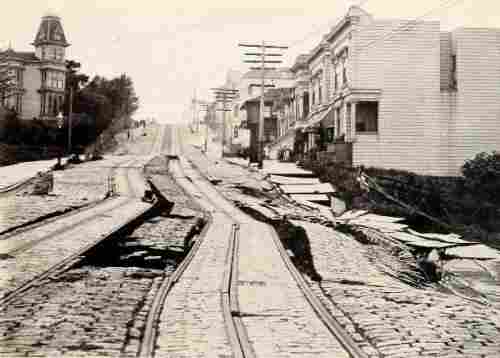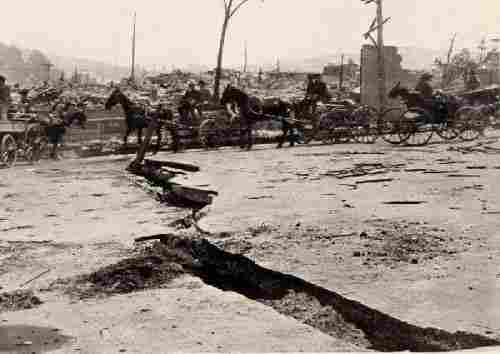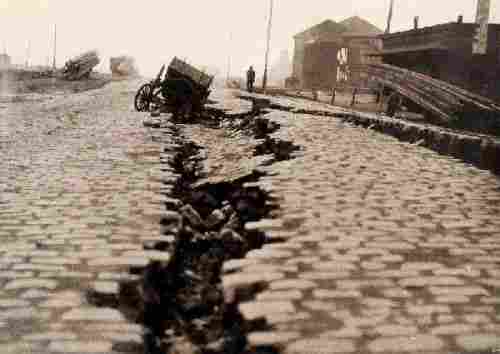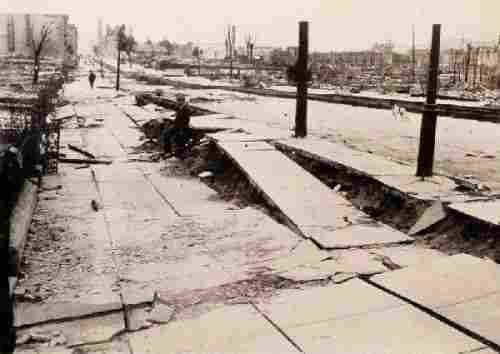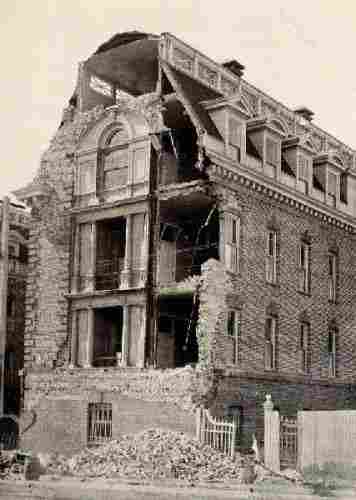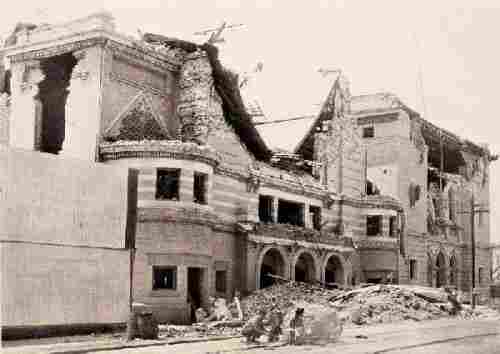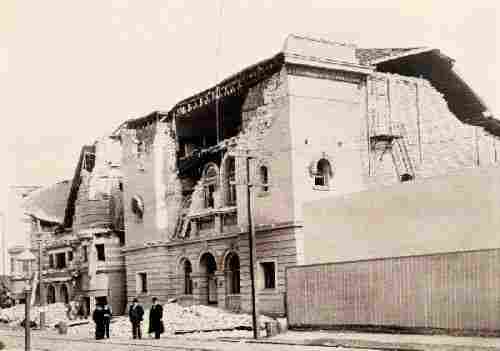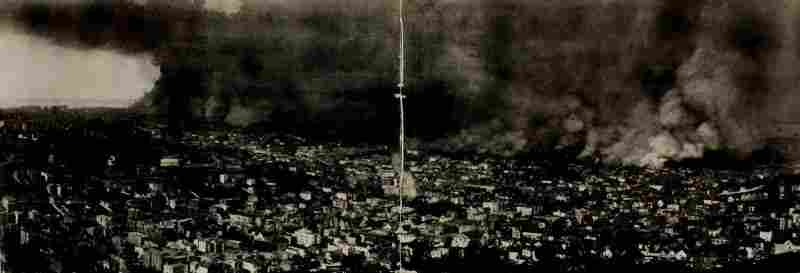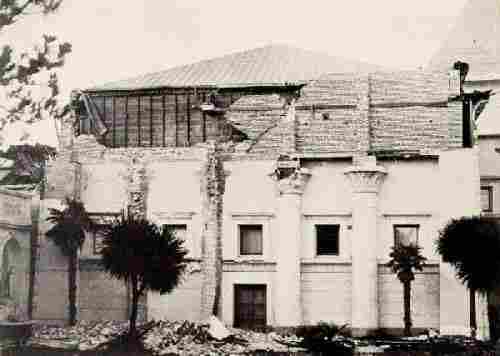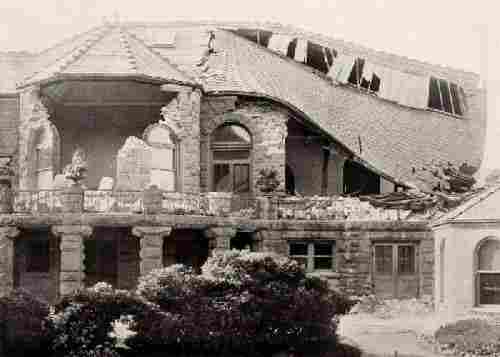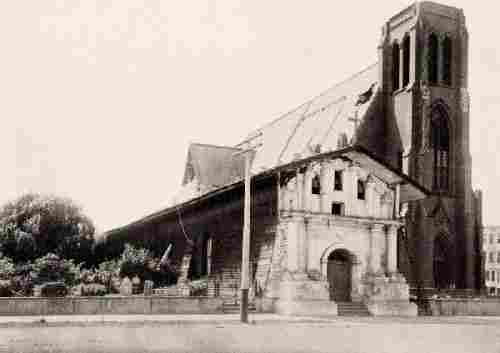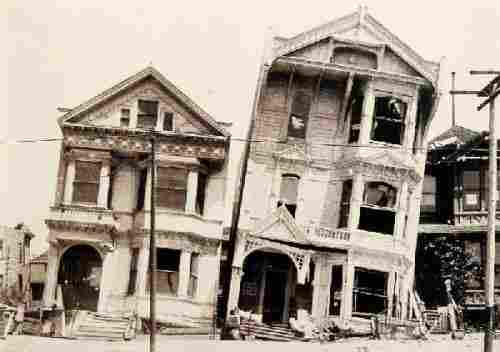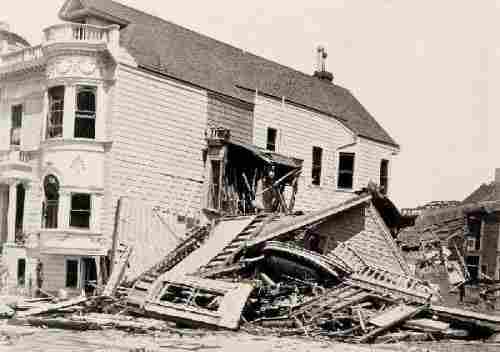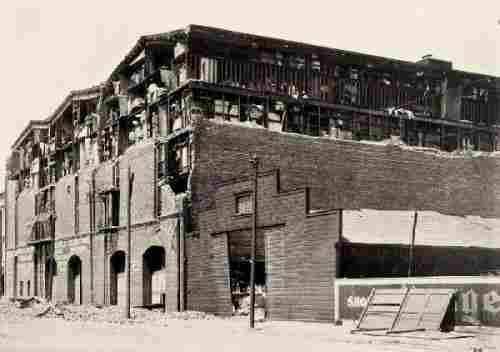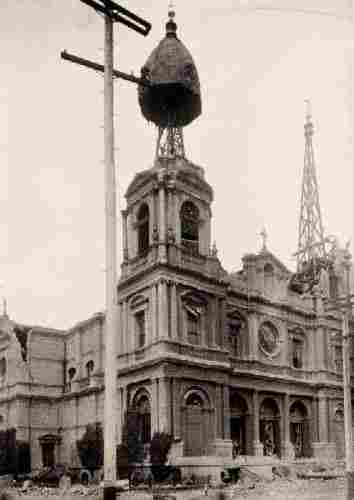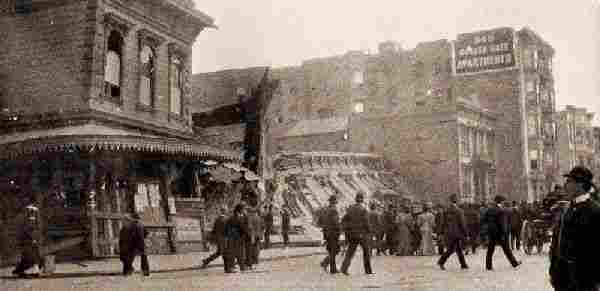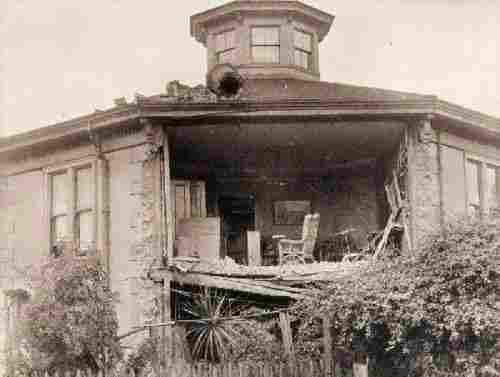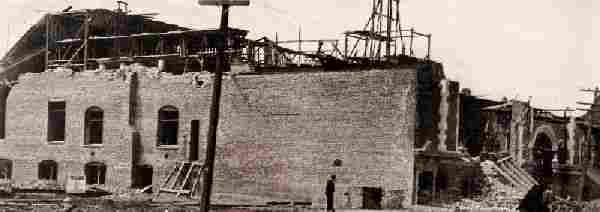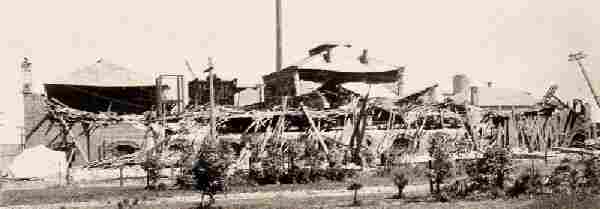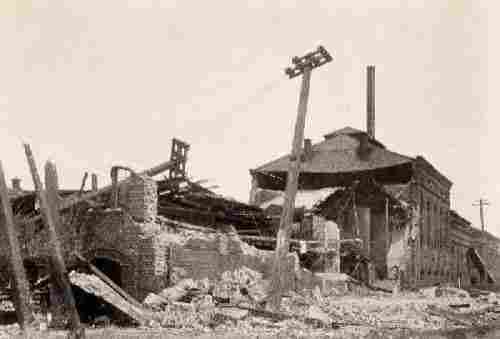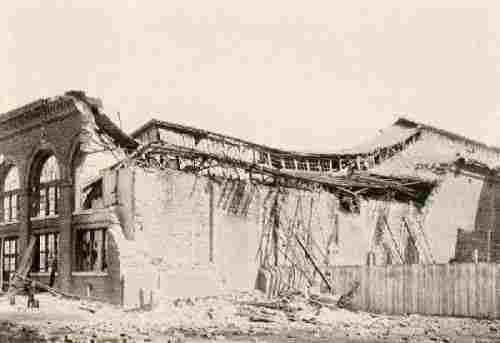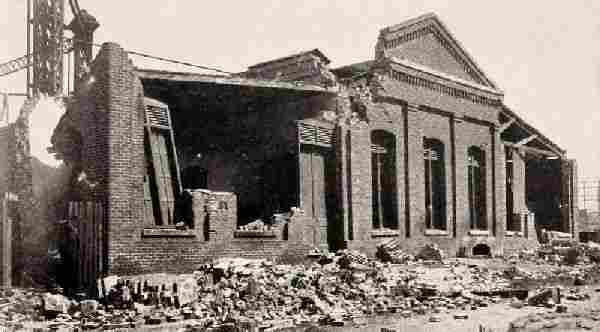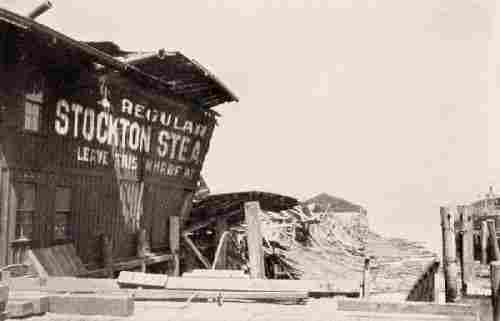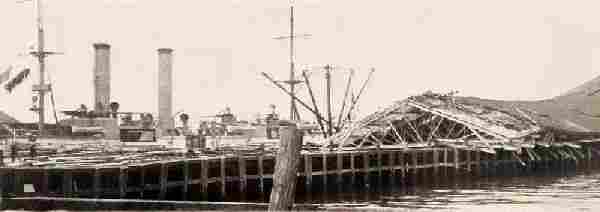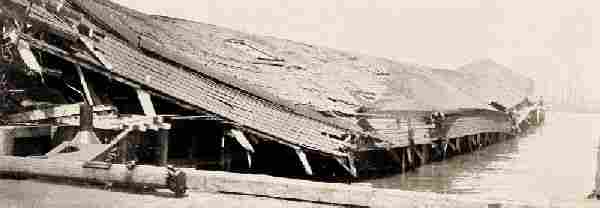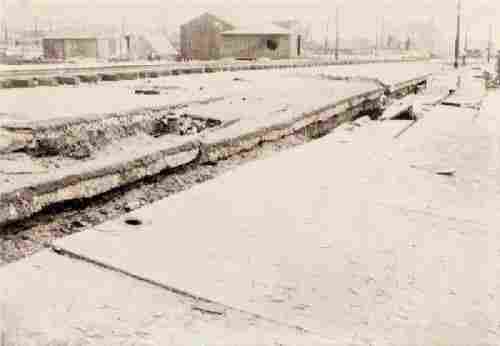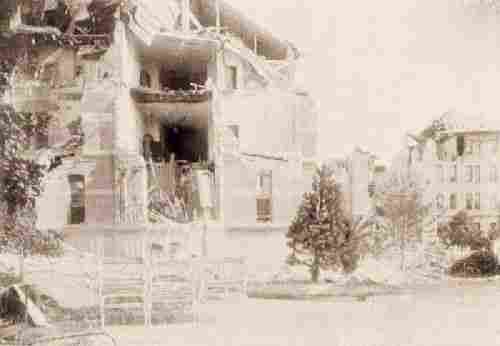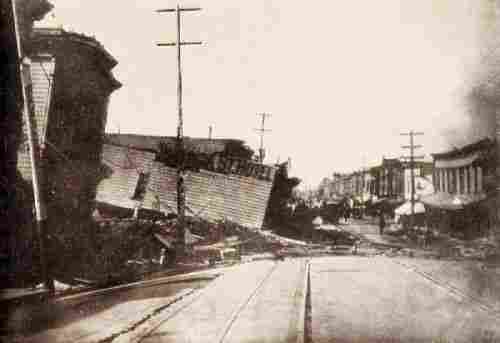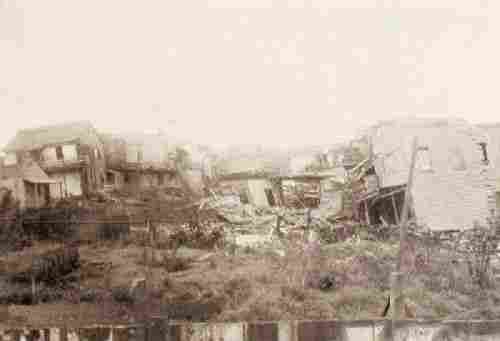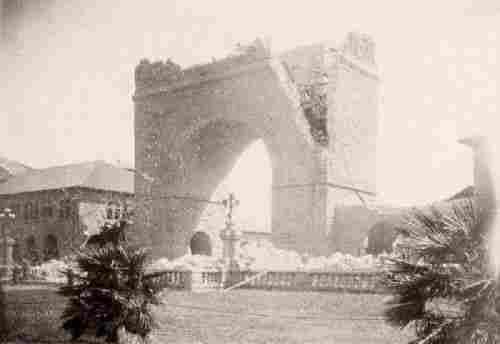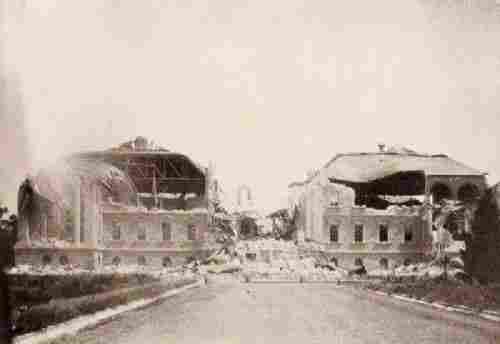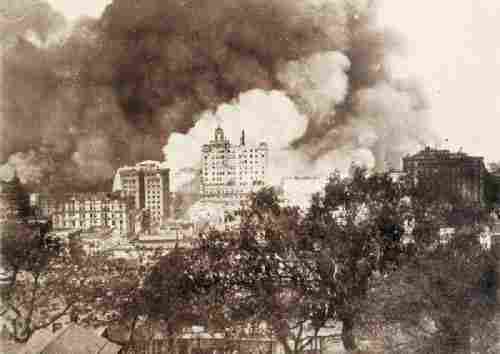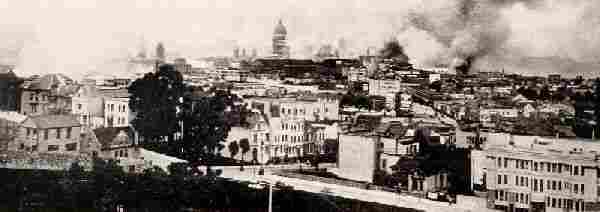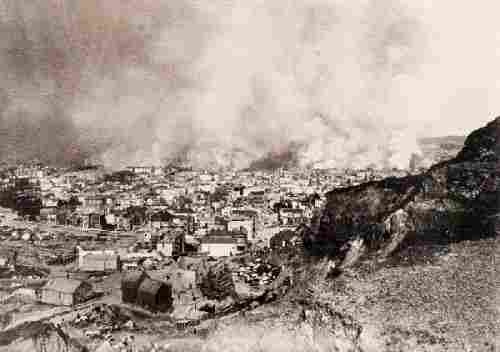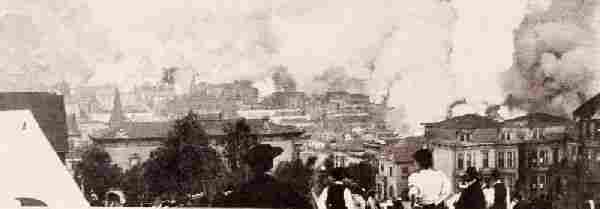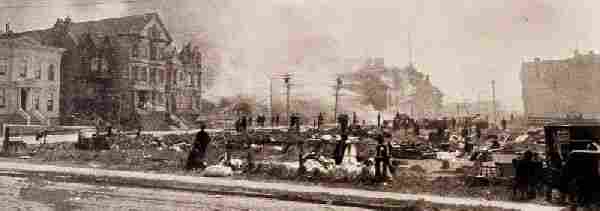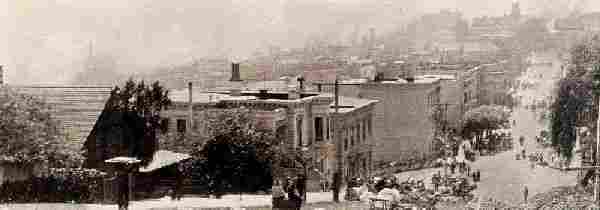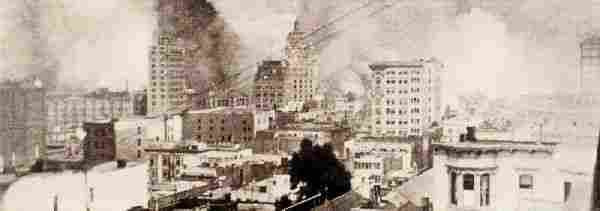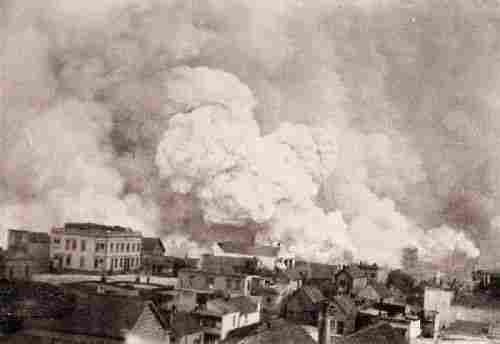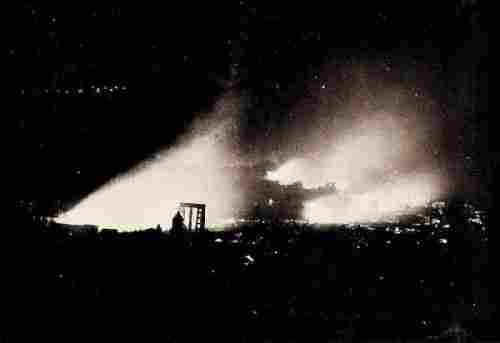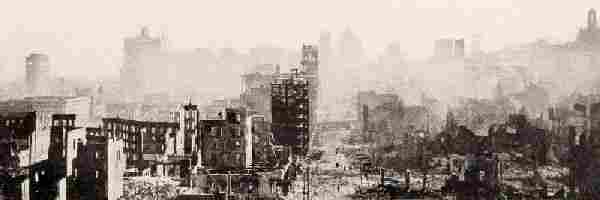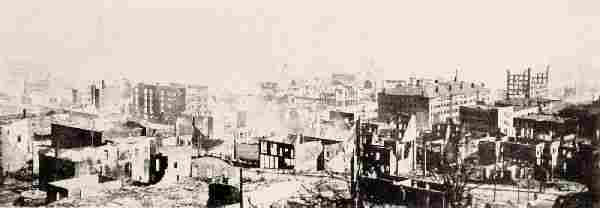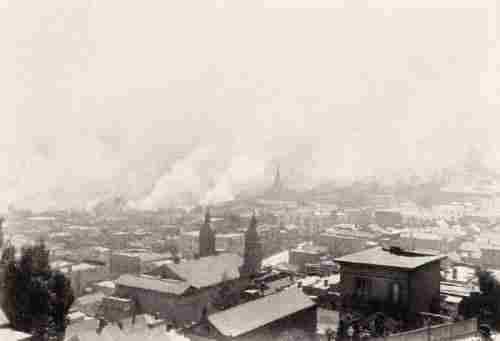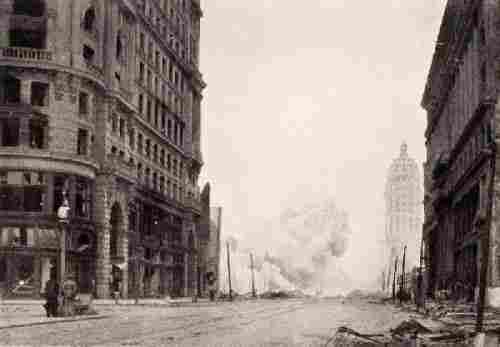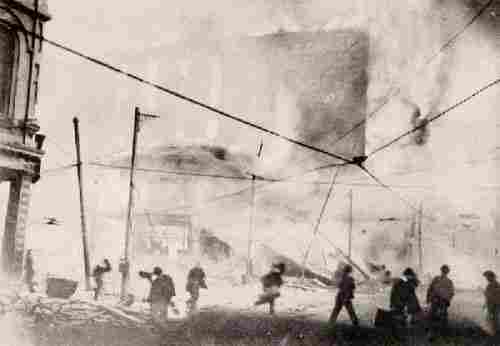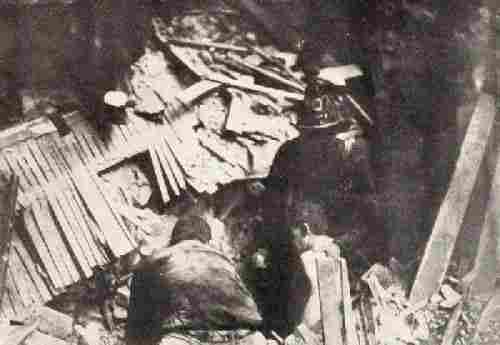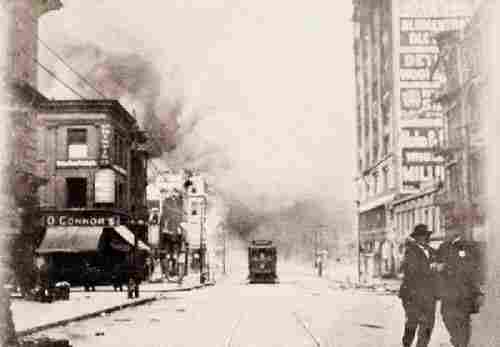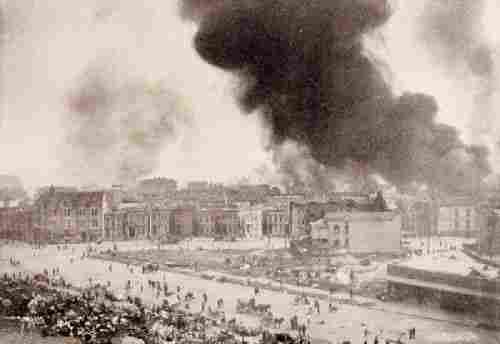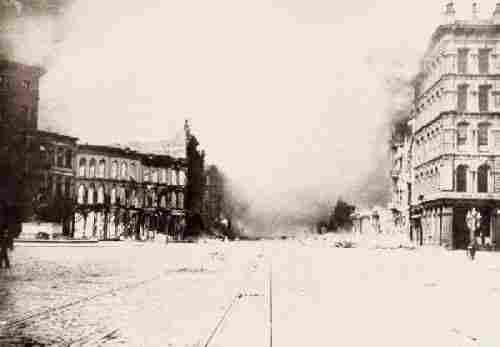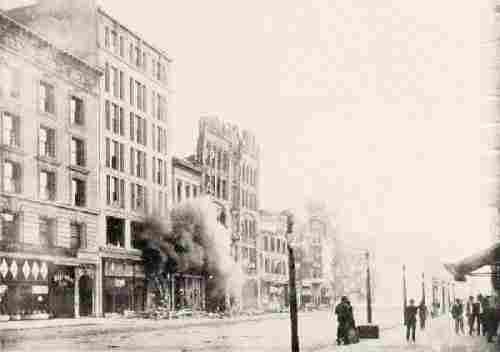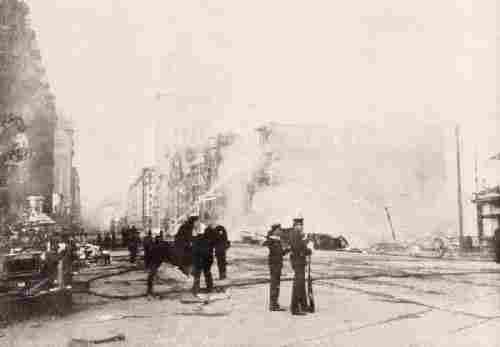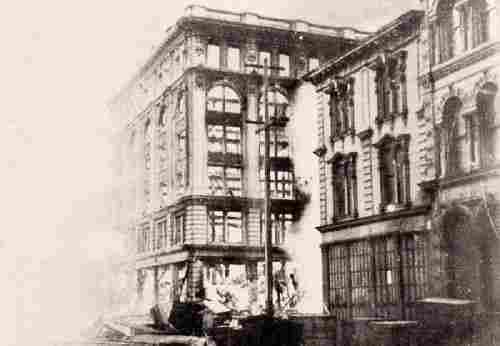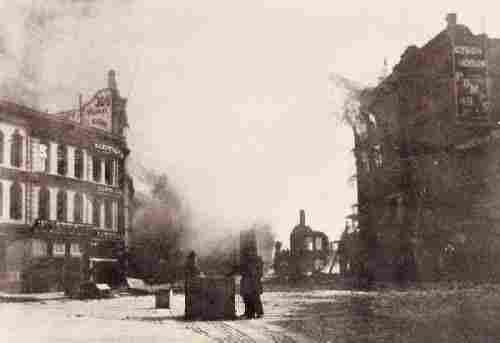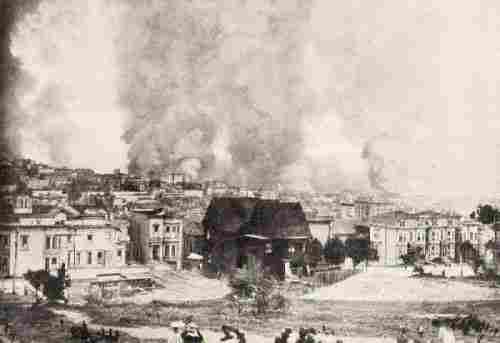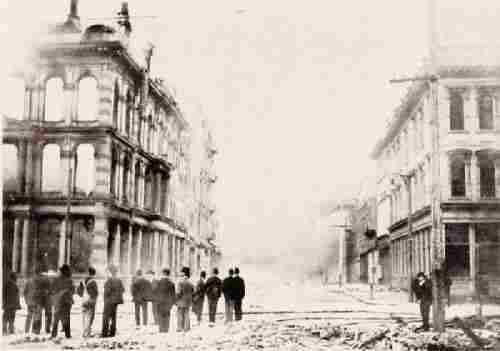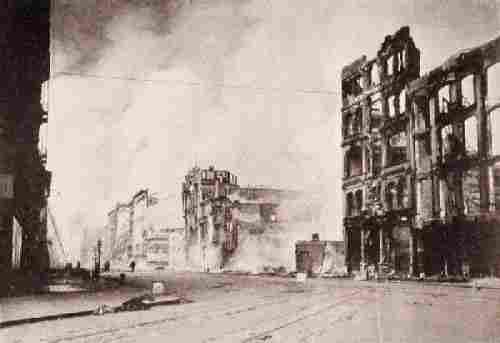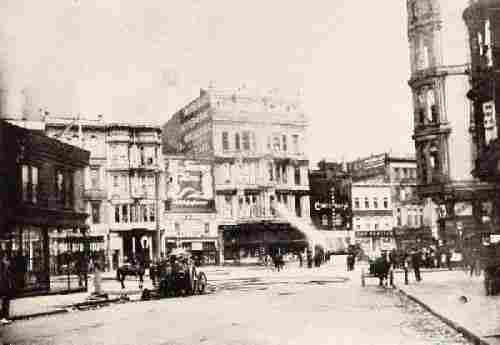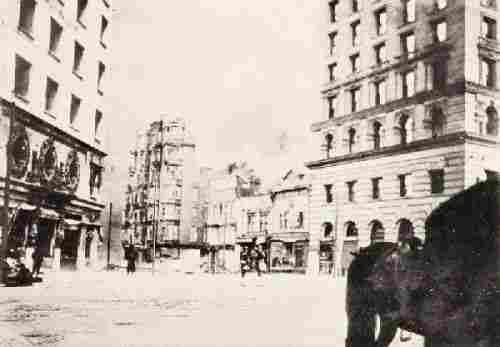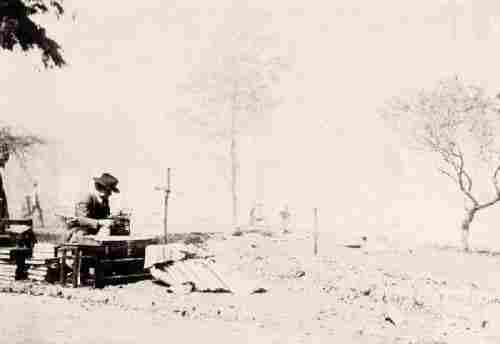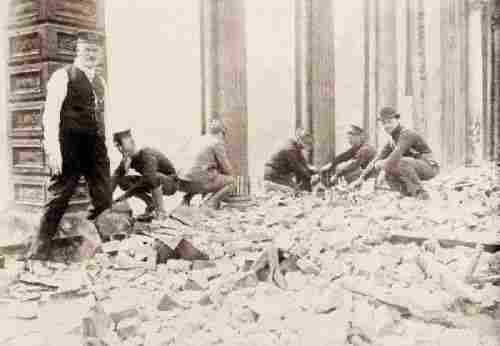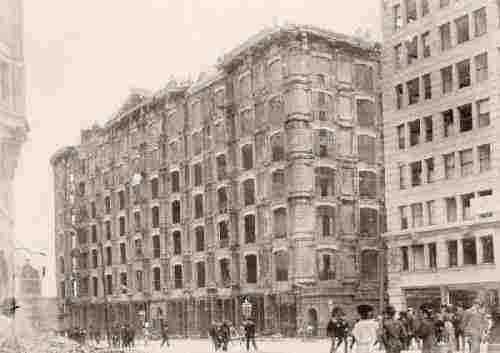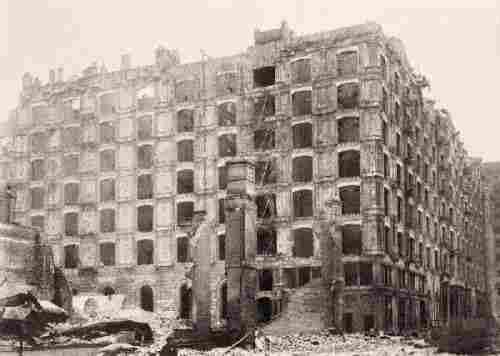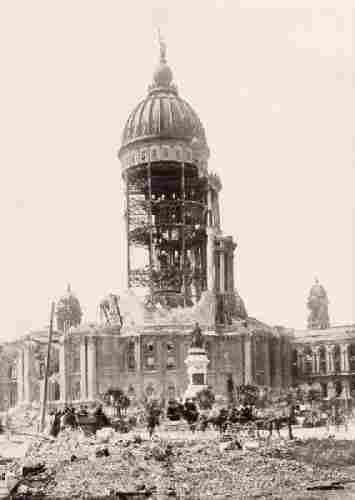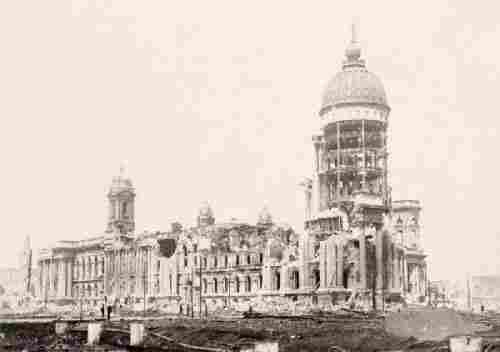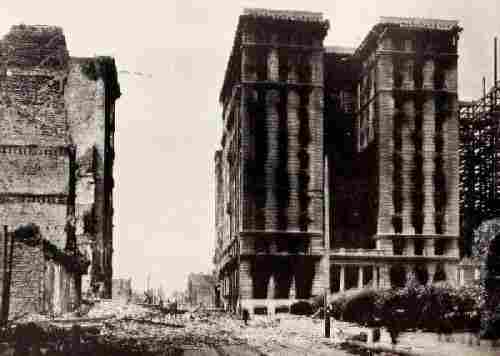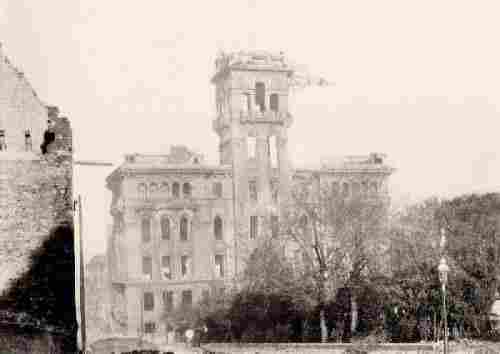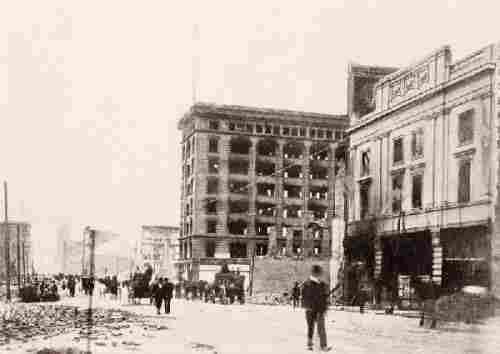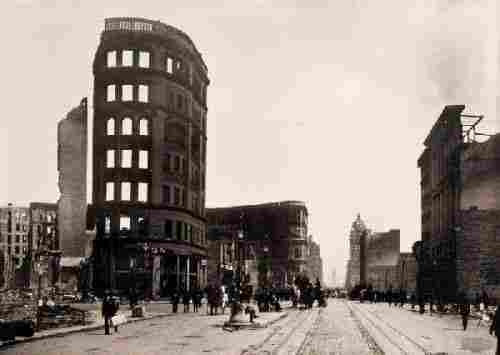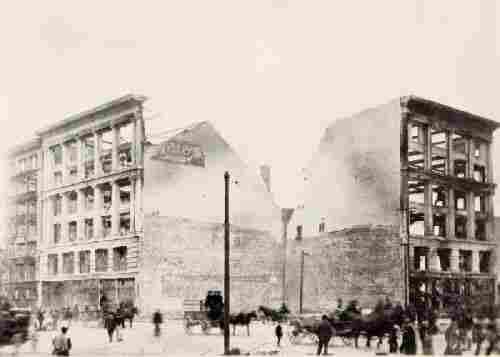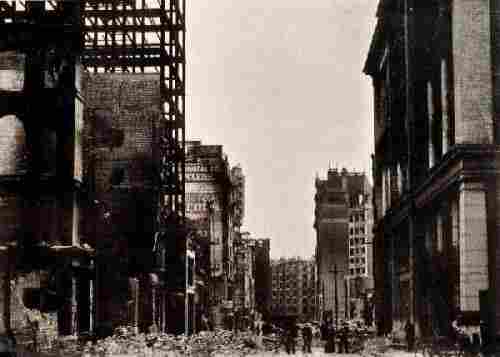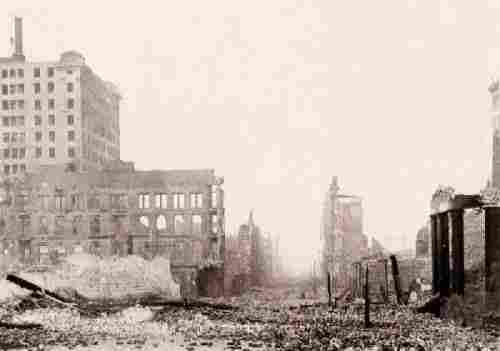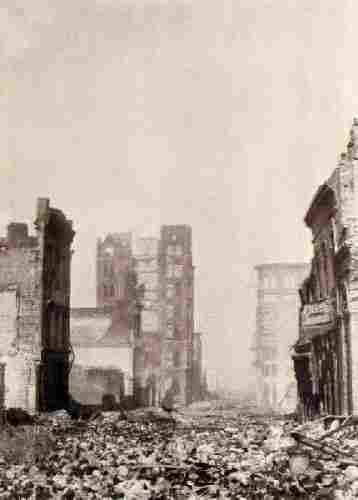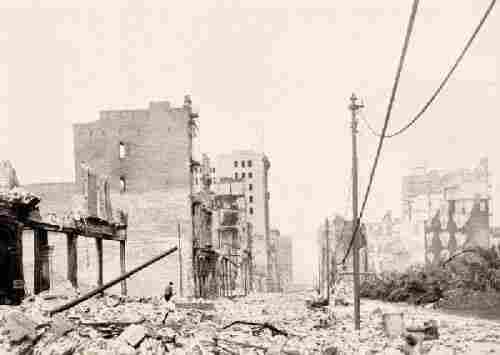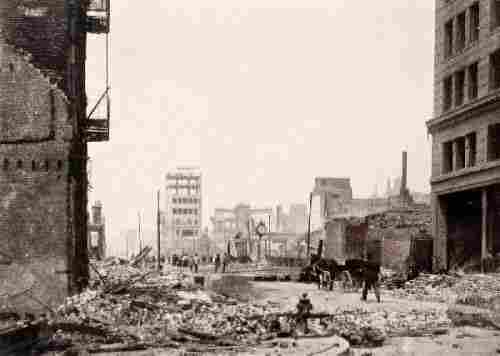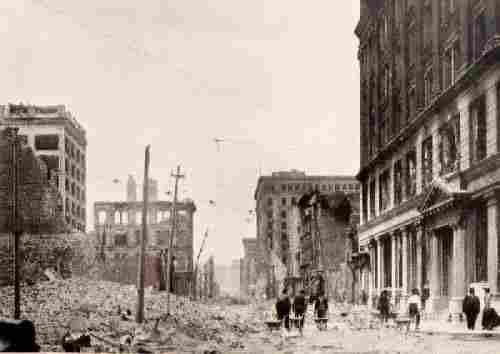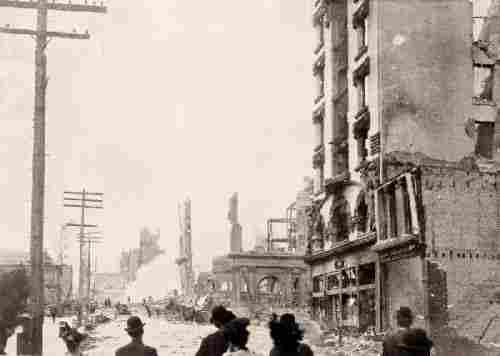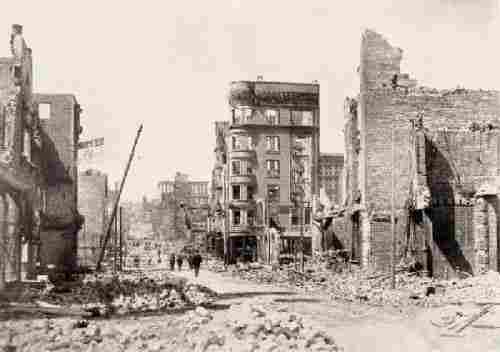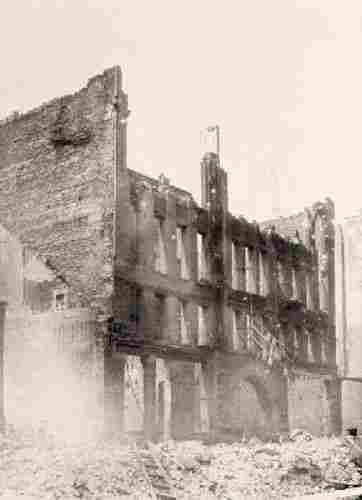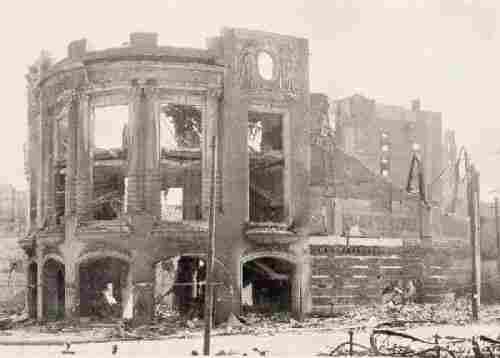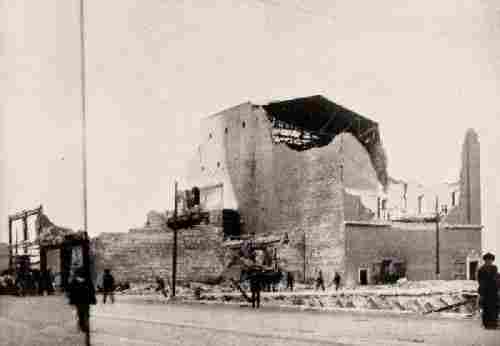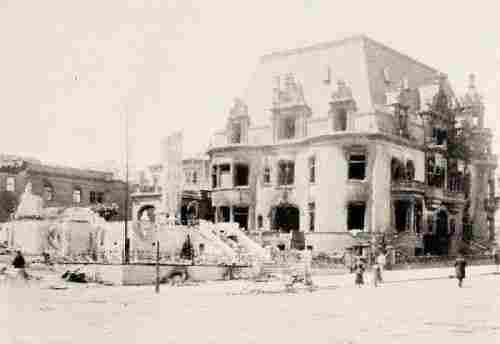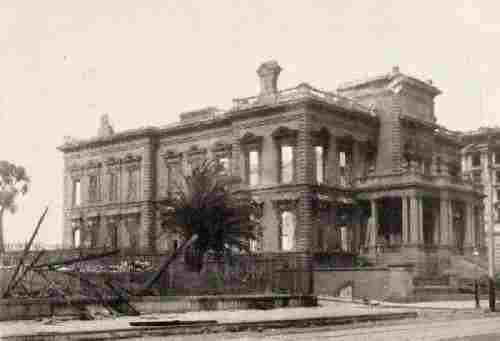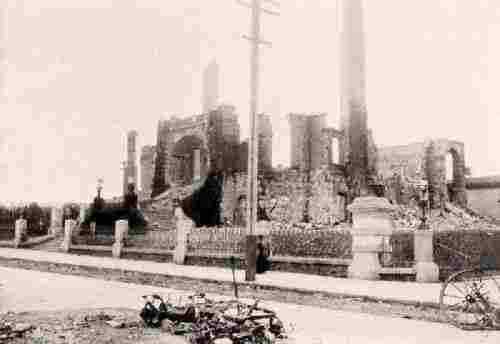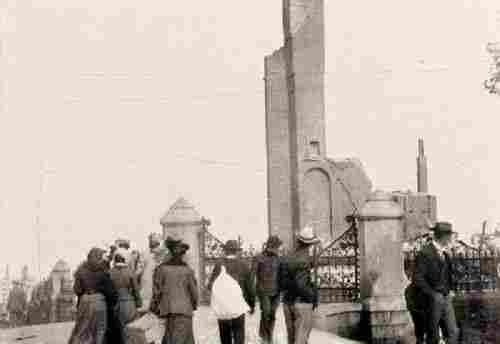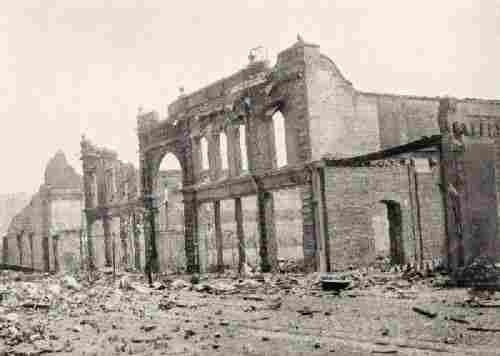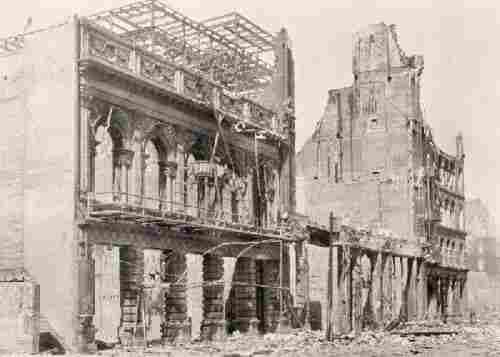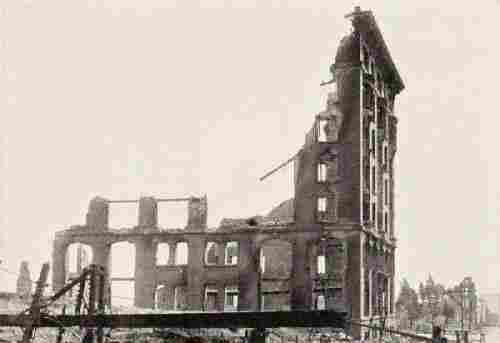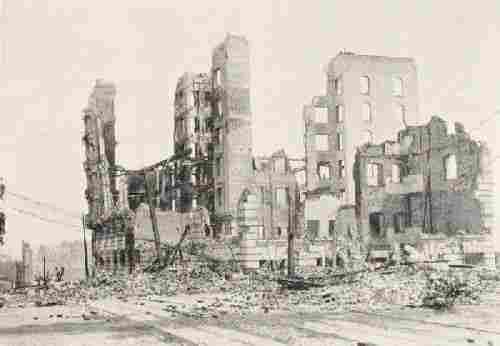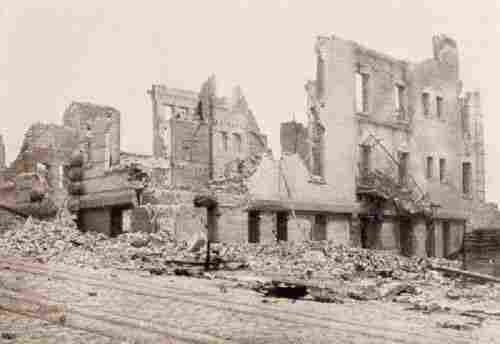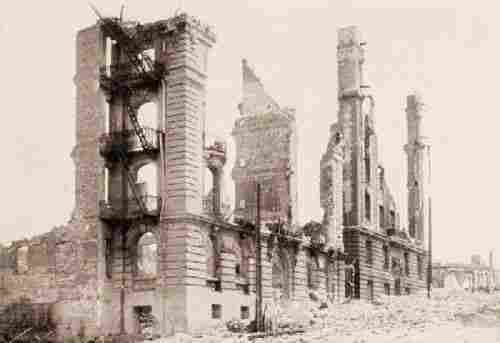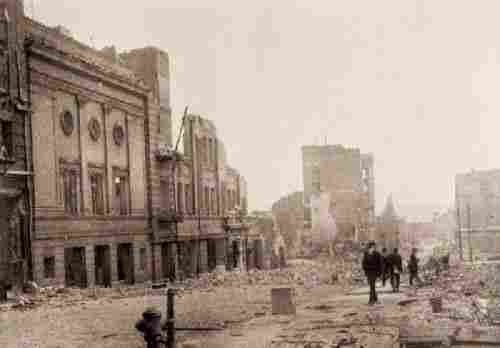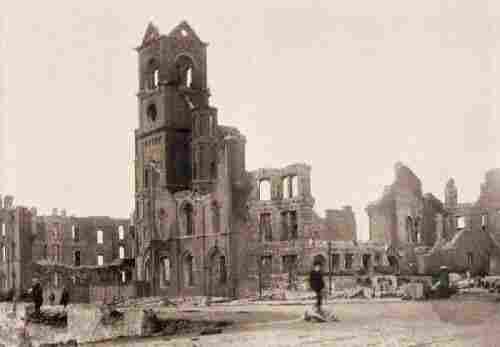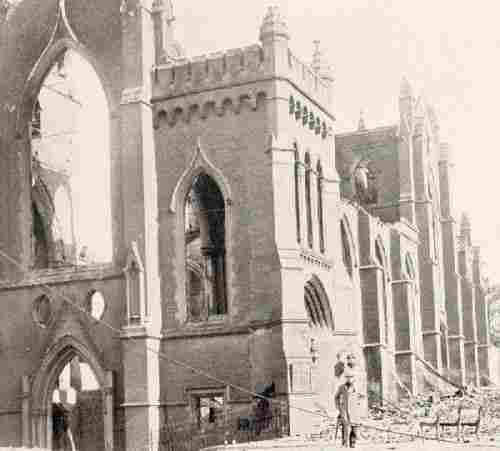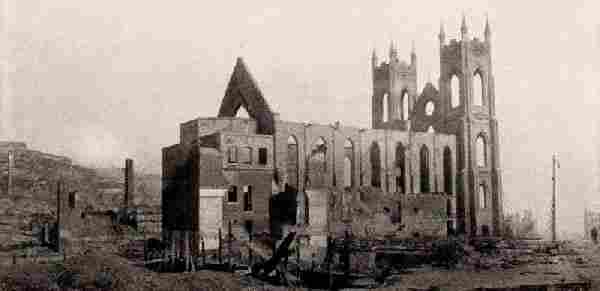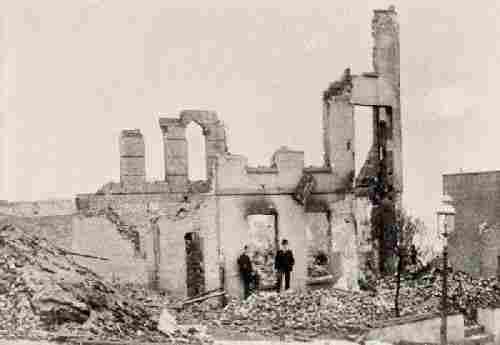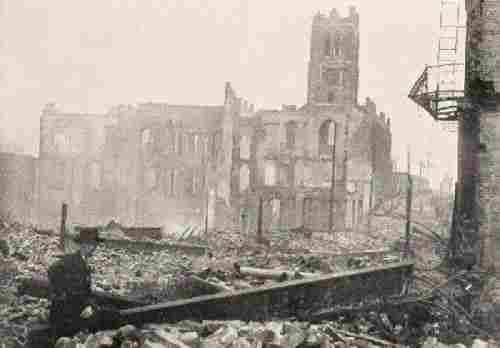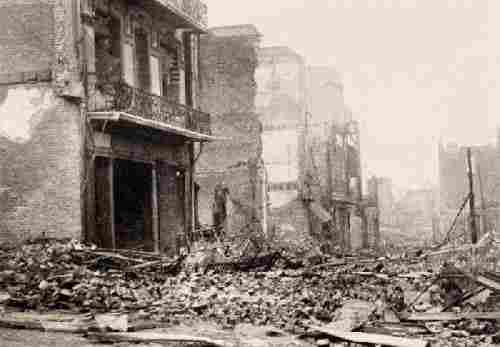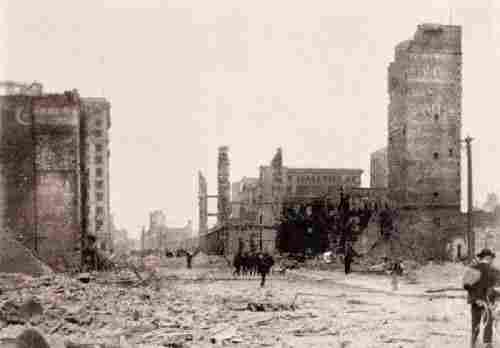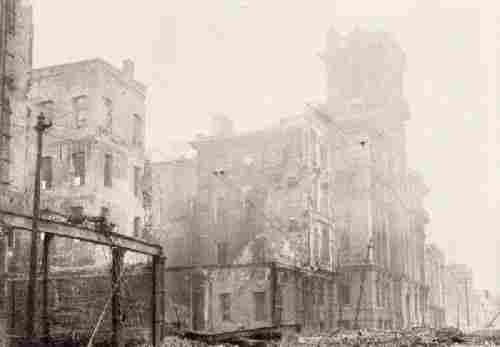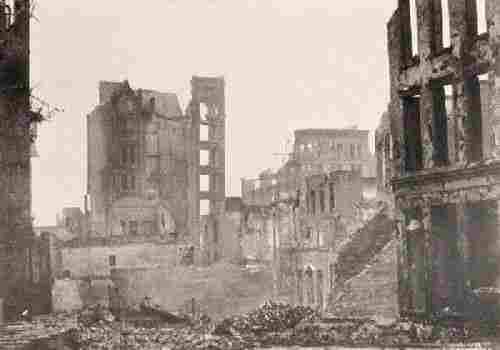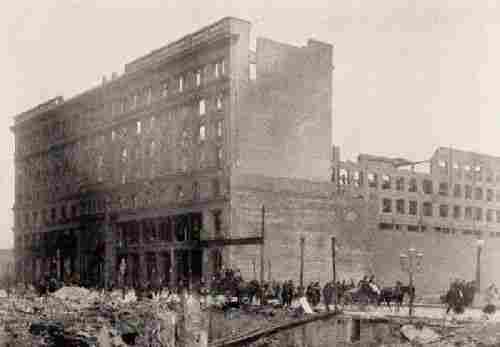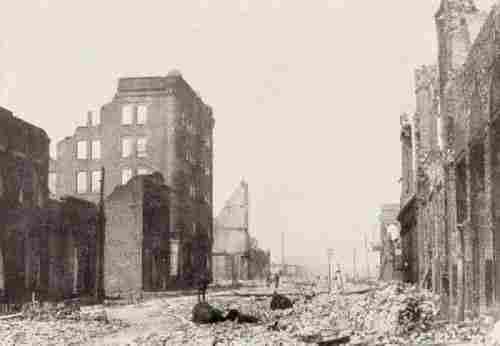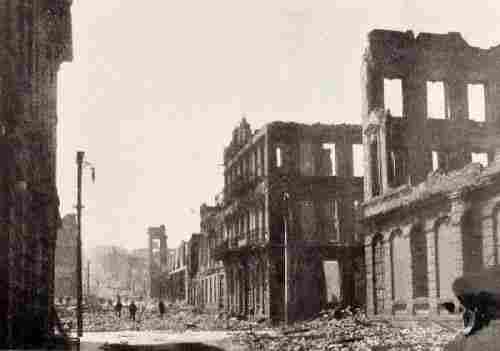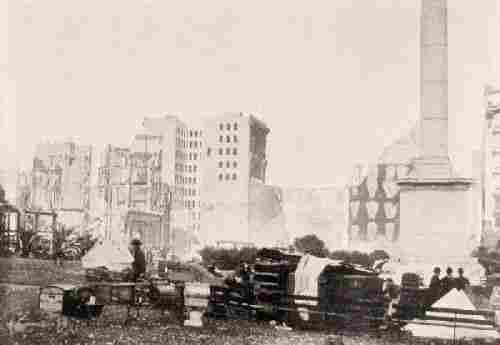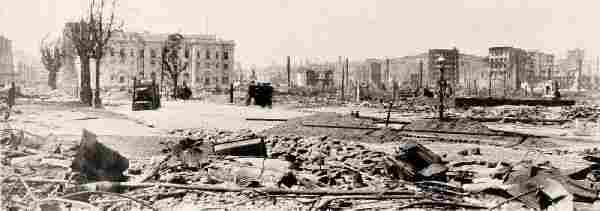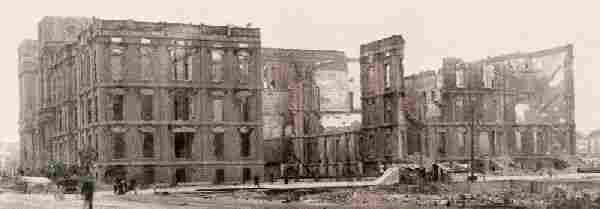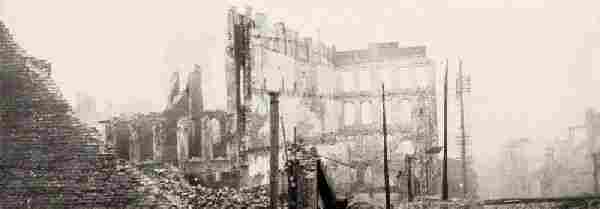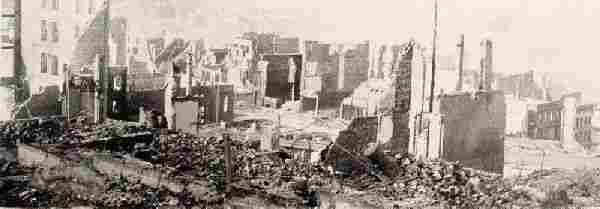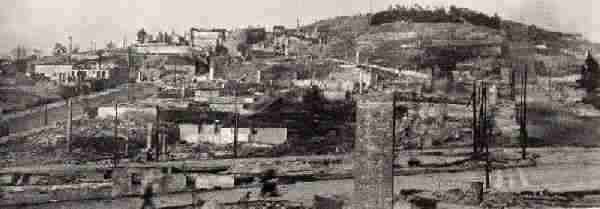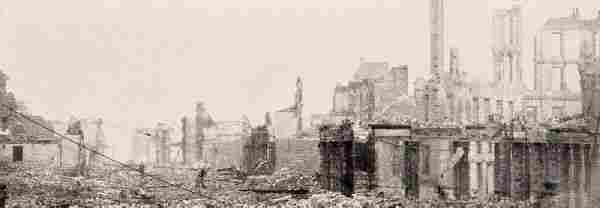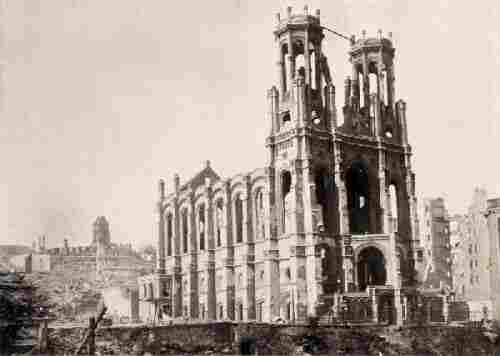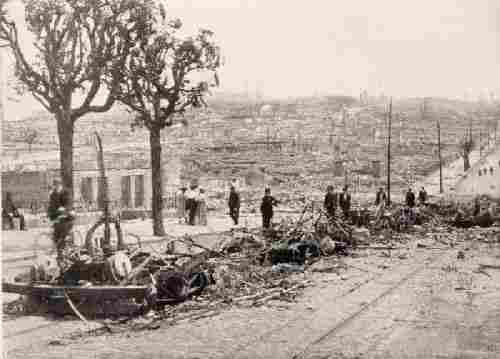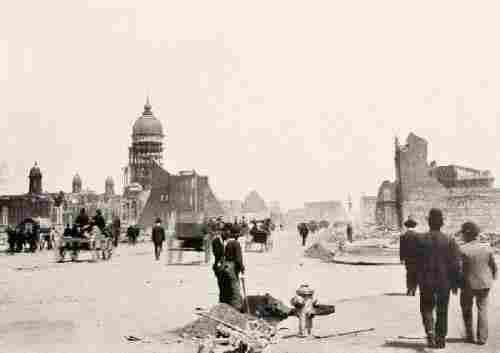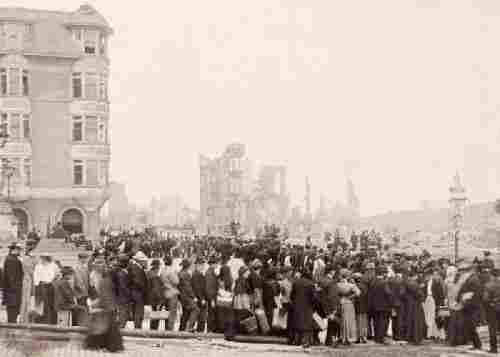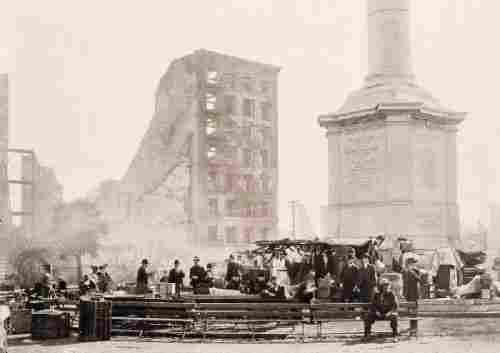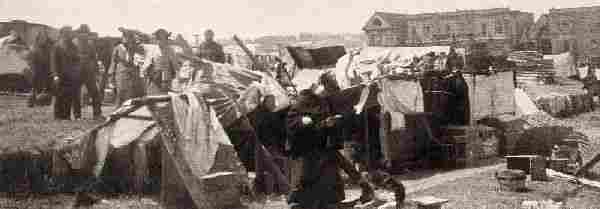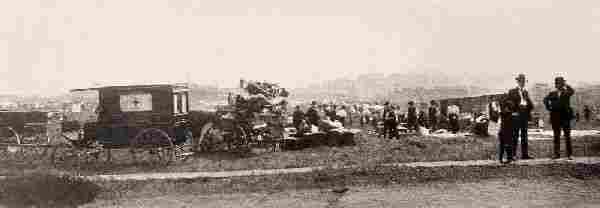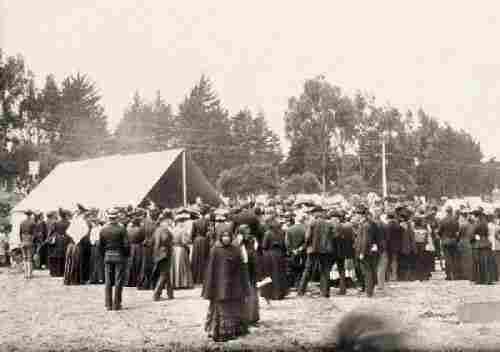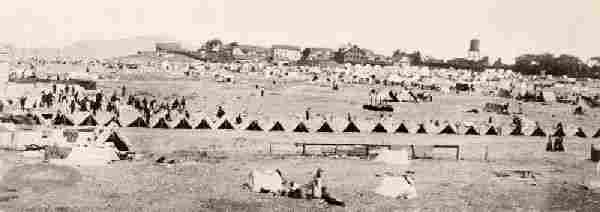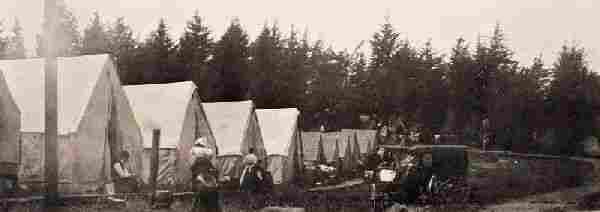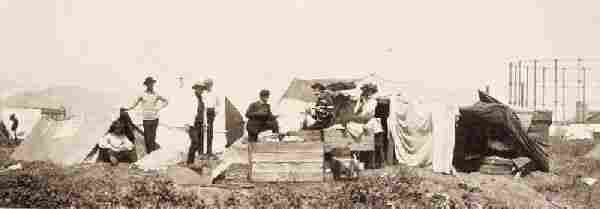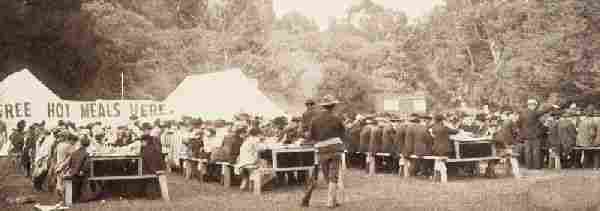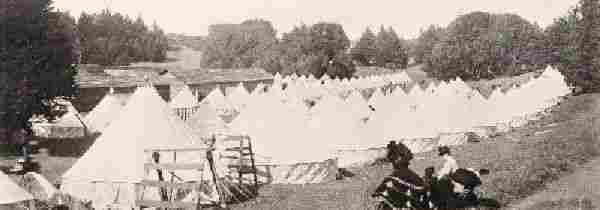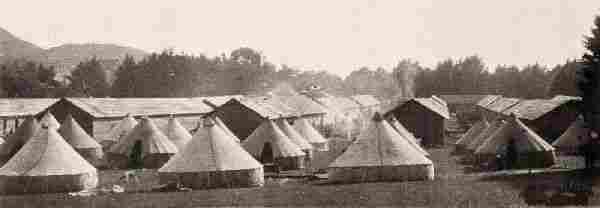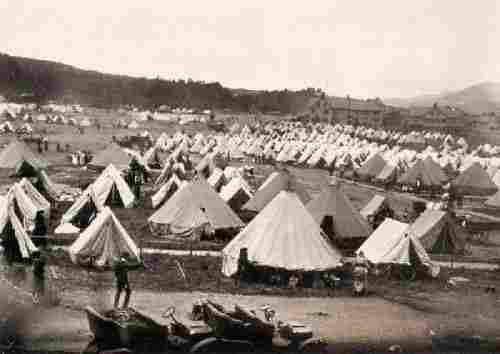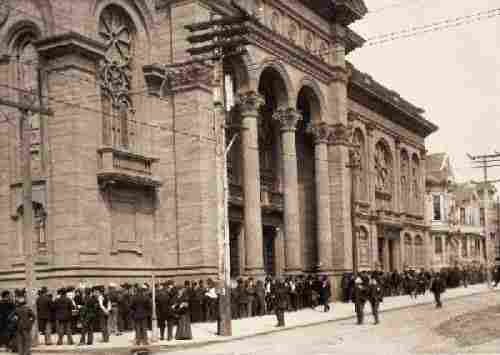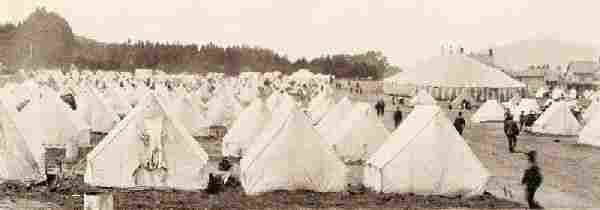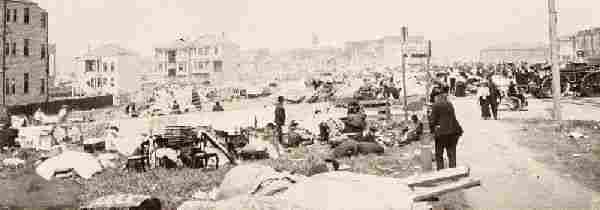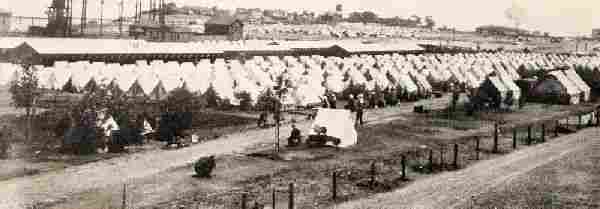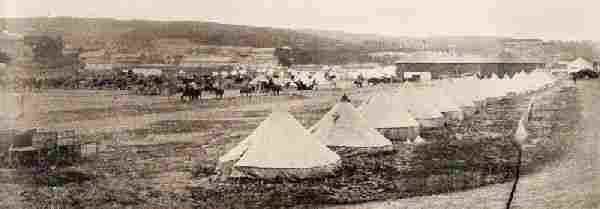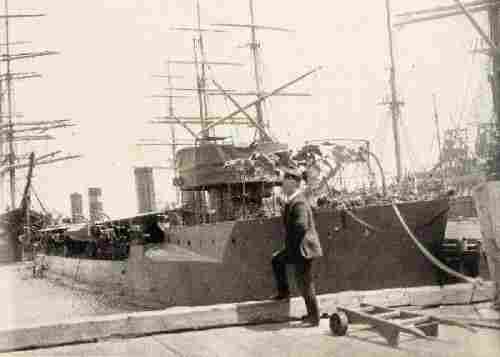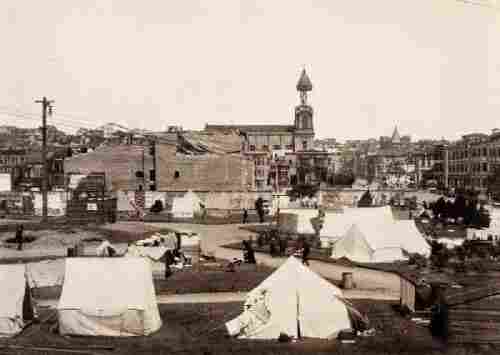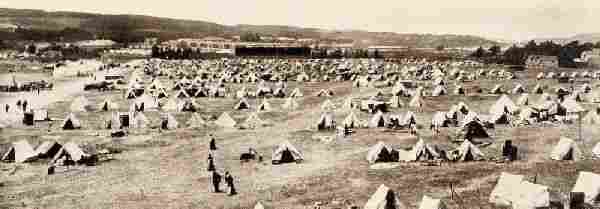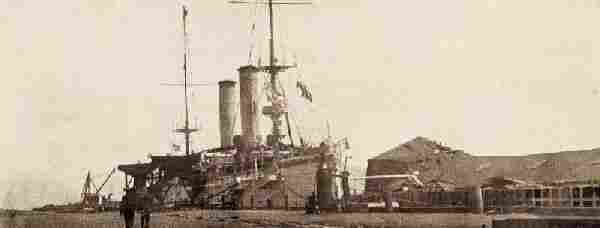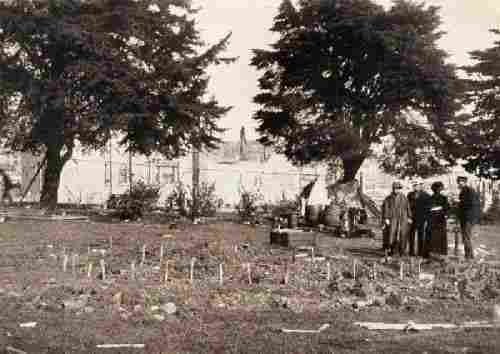.

SAN FRANCISCO
IN RUINS
A PICTORIAL HISTORY OF
EIGHT SCORE PHOTO-VIEWS
of the
EARTHQUAKE EFFECTS
FLAMES’ HAVOC
RUINS EVERYWHERE
RELIEF CAMPS
THE PHOTOGRAPHS BY J. D. GIVENS, PRESIDIO, SAN FRANCISCO, CAL.
Copyright, 1906, by A. M. Allison and J. D. Givens
ENGRAVINGS AND PRINTING BY THE SMITH-BROOKS COMPANY
DENVER, COLO.

| 1. | Brig. Gen. Frederick Funston, commanding Department of California. |
| 2. | Col. Wm. A. Simpson, military secretary. |
| 3. | Lieut. Col. George M. Dunn, judge advocate. |
| 4. | Col. John L. Clem, chief quartermaster. |
| 5. | Col. Edw. E. Dravo, chief commissary. |
| 6. | Col. Chas. L. Heizmann, chief surgeon. |
| 7. | Capt. Frederick R. Day, paymaster. |
| 8. | Capt. A. P. Buffington, paymaster. |
| 9. | Capt. Francis G. Irwin, paymaster. |
| 10. | Capt. Leonard D. Wildman, chief signal officer. |
| 11. | Capt. Wm. C. Wren, assistant to chief quartermaster. |
| 12. | Capt. Lawrence B. Simonds, assistant to chief commissary. |
| 13. | First Lieut. Burton J. Mitchell, 12th infantry, aid-de-camp. |
| 14. | First Lieut. Oliver P. M. Hazzard, 2d cavalry, aid-de-camp. |
| 15. | Second Lieut. Samuel E. Patterson, Philippine Scouts. |
COMMANDING GENERAL AND STAFF, DEPARTMENT OF CALIFORNIA, U. S. A.,
Headquarters, Presidio, San Francisco, Cal.
| THE FINISH OF THE FIRST EPOCH IN THE HISTORY OF |
SAN FRANCISCO |
The Queen City of the Pacific Slope, Guardian of the Golden Gateway to the Far East, the Islands of the Southern Seas, the Frozen Northland and the Sunny Ports of our Sister Continent
By A. M. Allison
 he historians of modern or ancient times have never recorded such a maelstrom of terrified, horror and panic-stricken human beings as awoke to the realization of the master seismic tremblor, in the City of San Francisco at 5:13 on the morning of April 18th, 1906. The initial quake, being followed by many of less severity, tumbled chimneys, large and small buildings of poor or faulty construction, broke water mains and ruptured electric light and power conductors, causing many conflagrations in a few moments. Then followed a catastrophe unparalleled in modern times, a disaster beside which, for property losses, the Chicago fire, the Johnstown flood, the Galveston tidal wave, the Mont Pelee eruption, Vesuvius’ spoutings and the Baltimore fire, fade into infinitesimal disturbances on the records of Father Time.
he historians of modern or ancient times have never recorded such a maelstrom of terrified, horror and panic-stricken human beings as awoke to the realization of the master seismic tremblor, in the City of San Francisco at 5:13 on the morning of April 18th, 1906. The initial quake, being followed by many of less severity, tumbled chimneys, large and small buildings of poor or faulty construction, broke water mains and ruptured electric light and power conductors, causing many conflagrations in a few moments. Then followed a catastrophe unparalleled in modern times, a disaster beside which, for property losses, the Chicago fire, the Johnstown flood, the Galveston tidal wave, the Mont Pelee eruption, Vesuvius’ spoutings and the Baltimore fire, fade into infinitesimal disturbances on the records of Father Time.
In three days, which seemed only as so many hours, there faded out of existence noble business blocks, grand and imposing structures, beautiful and superb residences the homes of the Argonauts, the sea kings, mining barons and merchant princes, together with the marts and dwellings of those who toil and delve and go down to the sea in ships, completely desolating and razing by fire three-fourths of this once beautiful metropolis of the whole Pacific Coast on either the northern or southern continents.
Nor was the City of San Francisco alone in its extremity, for many smaller and populous towns within a radius of seventy-five miles were subjected to the peril of the mighty corkscrew quakings, Santa Rosa being entirely shaken down; Salinas, San Jose, Palo Alto, Santa Cruz, Berkeley, Alameda and Oakland all suffering great property losses and some human lives. The beautiful structures of the Leland Stanford, Jr., University, at Palo Alto, all erected and endowed to a sum in excess of $40,000,000 by the late Senator Leland Stanford and his philanthrophic wife, were almost completely wrecked, including the Memorial Cathedral, which contained the largest and finest collection of mosaic pictures on the Western Hemisphere.
At no point in the affected area were the earthquake shocks so severe and destructive as in the down town district, south of Market and east of Kearny streets, where were the large office buildings, newspaper offices, banks, wholesale stores and warehouses, the occupants of which conducted the business, commerce and financial engagements of not only the major portion of the Pacific Slope, but a large and constantly-growing Oriental trade as well. The opportune hour of the morning was all that saved the lives of the untold thousands who labored there, but had not as yet left their homes in the residence sections of the ill-fated city.
Hardly had the mighty tremblor ceased its gyrations when innumerable fires broke out among the chaotic ruins, having caught from engine furnaces, broken electric wire conduits and spontaneous combustion, fed by the most inflammable of materials and fanned by a stiff breeze from the bay, grew and spread into what shortly became the most stupendous and widespread, as well as awe-inspiring conflagration, which any people of the eighteenth or nineteenth century have ever as yet looked upon or flown from. Had the water mains not have been ruptured, the splendid San Francisco fire department might have been able to cope with these many outbursts of flame at their inception, but deprived of water in the mains, they nobly fought the appalling[Pg iv] flames by pumping water from the bay at as many places as length of hose and their engines’ ability would permit; but their efforts to stay the onrushing, wide-spreading flames proved as a match’s flicker before a whirlwind.
It being quickly seen that the panic-stricken people would soon become a fleeing, dazed and terror-awed multitude, General Frederick Funston, commanding the Department of California, United States Army, with headquarters at the Presidio, immediately ordered out the cavalry, infantry and artillery forces under his command, who aided and directed the fleeing populace, gathered up and succored the wounded, established emergency hospitals, and policed the city. At the same time men-of-wars-men from the Mare Island Navy Yard, consisting of the battleship Ohio, the cruiser Chicago, and the torpedo boat destroyer Paul Jones, together with the ships of the United States Army Transport Service, and all available steam craft, attacked the flames along the water front and succeeded in saving much wharfage and the Ferry building, which is the principal gateway from the mainland.
Aided, ordered and guarded by the United States Army and Marine forces, assisted by the California National Guard, who were at once called out by the Governor, George C. Pardee, the excited and frenzied San Franciscans made their way to squares, parks and the open hills, over two hundred thousand fleeing to these places of refuge and another hundred thousand making their way by ferry-boats and other craft across the bay to the cities of Berkeley, Oakland and Alameda, caring for naught except to get away from the awful havoc and destruction of the place they once proudly called their City.
In untiring efforts to stay the flames the army, navy, marine corps and police used artillery fire, gun-cotton, dynamite and rhyolite in back-firing, sacrificing whole blocks of splendid residences and other structures to retard the unquenchable ever-advancing line of fire, which at times extended unbroken for over three miles in length. At last, at the dawn of Saturday, April 21st, after three days and nights of valiant effort, the wind subsided and the flames died down to rise no more; but not until after they had swept the once proud and majestic city from the Ferry building to Van Ness avenue, ruining all the residences on the west side of that broad, stately boulevard, to Twentieth and Guerrero streets in the Mission, and from the waters of San Francisco bay to the Golden Gate itself. Not in all this vast section, measuring over sixteen square miles, did one single habitation escape the shock of the giant tremblor or the all-devouring flames, with but a few exceptions, viz.: the United States Mint, the United States Custom House, the United States Postoffice, which was damaged one-half a million dollars’ worth by made-land sinking away from it, the new unfinished newspaper building of the Chronicle, and the new building of the California Casket Company just erected, but not wood-finished. Every other building, of whatsoever class, kind or construction, was tumbled, crumbled, shaken down, or absolutely gutted by the fierce flames in which granite dissolved to powder and steel beams melted and buckled like a watch’s freed mainspring; where cobble-stones scaled and chipped off and marble slabs disintegrated and became as bone-dust to the touch.
No computer or statistician lives who could accurately arrive at the monetary loss, variously estimated at from three hundred and fifty to four hundred millions of dollars. Nor will the loss of human life ever be known, said to be from fifteen hundred to two thousand; many more are known to have perished in the lodging houses and cheaper hotels located in the district south of Market street, as well as in the poorer districts, of which no returns will or can ever be made; many identities were lost both in and out of unidentified graves.
On the cessation of the first quake and the breaking out of the flames all means of surface transportation was rendered useless, except the automobile, which did good and swift work in rescuing the wounded and carrying the living to places of safety, as well as transporting dynamite and other high explosives to the busy fire-fighters, also rendering invaluable aid in getting food and water to the refugee camps in the parks, when the relief trains, so generously and beneficiently forwarded by all the cities of the land, began to arrive laden with provisions and clothing for the hungry and the destitute. The sister city, Los Angeles, which by her nearness was enabled to supply physicians, nurses and medical supplies, as well as foodstuffs, getting the first relief train to the stricken city on the night of the first day.
Congress appropriated money, private citizens throughout the broad land gave of their wealth. Army and navy stores and the cargoes of many merchantmen in the harbor were all made available, and thus famine and disease were prevented and lives which would have flickered and then passed out were saved, encouraged and strengthened for the monumental task of raising a grander, greater, safer and more beautiful New San Francisco phoenix-like from the ashes of the City of the Forty-Niners.
These are the words; the pictures tell the tale much better; pictures the like of which, it is earnestly hoped, will never be presented by any camera again while the earth rolls around.
Section of the Union Street Cable Line, Between Steiner and Pierce Streets,
Distorted by the Earthquake.
Break in the Asphalt Paving on Van Ness Avenue, Near Vallejo.
Break and Two-foot Sink in East Street, Near Ferry Building.
Break and Sink in Capp Street, Between Seventeenth and Eighteenth Streets,
in the Mission District.
Effects of Shock on Hahnemann Homeopathic Medical College,
on California Street, Near Maple.
Effects of Shock on Newly-Constructed Temple Beth-Israel, 1817 Geary Street,
Western Addition.
Effects of Shock on One-year-old Albert Pike Memorial Temple, A. A. S. R.,
1825 Geary Street, Western Addition.
(Photograph Taken and Copyrighted by H. S. Hooper, Oakland, Cal. Permission Secured.)
View of the City of San Francisco on Fire.
The Only Photograph Obtained Showing the Entire Scope and Extent of the Great Conflagration.
Fire Line Over Three Miles Long, Extending from North Beach, Golden Gate, to Twenty-first Street, Mission.
Effects of Shock on western side of Memorial Museum, Golden Gate Park,
a Structure of the Mid-Winter Exposition.
Effects of Shock: Total Wreck of the Children’s Play-House, in Golden Gate Park;
a City Building.
Effects of Shock on Dolores Mission, the Oldest Building in the City;
Tower of the New Church, Which Will Have to Be Rebuilt.
Effects of Shock on Two Frame Residences on Howard Street, Near Eighteenth,
in the Mission.
Effects of Shock on Frame Residence on Folsom, Near Seventeenth Street,
in the Mission.
Effects of Shock on the Pierce-Rudolph Storage Warehouse, Fillmore Street.
Effects of Shock on the Cathedral of St. Dominic,
Steiner and Bush Streets.
Effects of Shock on Two-story Frame Residence on Golden Gate Avenue.
Effects of Shock on the “Octagonal House,” a Residence on Gough Street,
Near Union.
Effects of Shock on New Golden Gate Commandery, K. T., Building, in Course of Construction,
Steiner and Sutter Streets.
Effects of Shock on the San Francisco Gas and Electric Company’s Power-House, Near Fort Mason.
Effects of Shock: Another View S. F. G. & E. Co.’s Power-House.
Effects of Shock: S. F. G. & E. Co.’s Gas-House, Near Fort Mason.
Effects of Shock: Another View S. F. G. & E. Co.’s Gas-House.
Effects of Shock: Collapse of the Stockton Steamer Wharf, Water Front,
Near Ferry Building.
Effects of Shock: Wrecked Wharf No. 9; U. S. Cruiser Chicago Alongside;
the Ship’s Pumps Protected Much Wharfage Near This Point.
Effects of Shock: Collapse of Wharf No. 7, Near Ferry Building.
Effects of Shock: Separation of the Sidewalk from the Asphalt Paving on Capp Street,
Between Seventeenth and Eighteenth Streets.
Effects of Shock on the State Asylum at Agnews, Cal.
Effects of Shock: Wreck of the Valencia Hotel, Twentieth Street, in the Mission;
Four-story Frame Structure, Sunk Two Stories Below Street Surface;
Sixty-four Lives Lost.
Effects of Shock: Wreck of Two-story Frame Homes on Brannan Street,
Rincon Hill District.
(Photograph Taken and Copyrighted by Stewart & Rogers Permission Secured.)
Fire Scene of the Entire District South of Market Street, from Stuart and Mission Streets to Sixth and Mission Streets;
Also, Showing the Great Hotel, Newspaper and Retail Centers of the City North of Market Street at Noon of the First Day;
on the Second Day All the District Shown in This View Was Entirely Flame Swept.
Effects of Shock: Wreck of Memorial Arch at Leland Stanford Jr. University,
Palo Alto.
Effects of Shock: Wreck of New Gymnasium Building at Leland Stanford Jr. University,
Palo Alto.
Burning of Financial and Wholesale District, Taken from Portsmouth Square,
Showing to the Ferry Building.
Fire Line at City Hall, Raging South of Market Street and on Golden Gate Avenue, First Day.
Fire Line Raging in Mission District, from Twentieth and Guerrero Streets to Potrero Heights, Second Day.
Fire Enveloping Potrero Heights, Second Day.
Entire District Burned Over Later Same Day.
Fire Advancing on Rincon Hill District, South of Market.
Fire Reaching Van Ness Avenue, Near Green Street, on Second Day.
From Pacific Heights at Vallejo Street, Fire Line Now at Van Ness Avenue,
Residents Prepared to Flee to the Presidio Reservation.
Fire Line South of Market, Early on First Day, Left to Right, Shows Palace Hotel, New Chronicle,
Examiner and Call Newspaper Buildings, Mutual Savings Bank and New Shreve Office Buildings.
Flames Consuming the Rincon Hill District, First Day.
Night Scene: Rincon Hill, from Mission and Howard Streets to Pacific Mail Dock.
Looking Up Kearny Street Towards Market, from Broadway; in the Right Foreground Little Italy.
From Telegraph Hill, Overlooking the Wholesale District;
in Right Center the Appraisers Building, U. S. Custom House.
Unscathed by Either Earthquake or Flames.
Looking from Russian Hill Towards the Ferry Building and Fairmount Hotel;
Fire Raging in Chinatown.
From Center of Market Street at Powell, Flood Building on Left,
the Emporium on the Right, Call Building in Distance, South Side.
One of the First Outbreaks of Flame Immediately After the Earthquake,
Third and Mission Streets.
Removing the Wounded and Dead from the Wreck of the Brunswick Hotel,
Mission Street.
Looking Down Third Street from Market; Trolley Cars Were Consumed Where
They Had Been Deserted at the Moment of the Earthquake; a Policeman Taking
a Man Bereft of Reason Through Fright and Terror, to a Place of Safety;
Many Persons Went Insane.
Citizens Rendezvousing on the Vacant Places When the Fire Was Raging in the
Mission District.
Looking Towards the Ferry from Front and Market Streets on the First Day.
Looking West from the Corner of Kearny on Market Street, First Day.
On Market, Looking Towards the Ferry; Phelan Building on Left,
the Call Building and Palace Hotel in Distance; First Day.
Murphy, Grant & Co.’s Building, Corner Bush and Sansome Streets.
Fire Scene in First Street, Looking from Market, First Day.
A View of the Fire from LaFayette Square.
Taken from Russian Hill: General View of the Ruins of the Wholesale, Financial and Retail Districts; Also, Entire Scope of Chinatown;
the Streets from the Fairmount Hotel, at California and Mason, Are Sacramento, Clay, Washington, Jackson and Pacific.
Corner of Sansome and Market Streets; London, Paris & American Bank on Left;
Wells, Fargo & Co. Bank on Right.
View from McAllister Street Looking East Along South Side of Market Street.
At the Junction of Stockton, O’Farrell and Market Streets; Forenoon of First Day;
Destroyed That Night.
At Kearny and Market, Looking Into Third Street; Examiner Building on Left and
Call on Right Side.
Receiving Messages in Portsmouth Square; Also Coroner’s Temporary Interment
Ground of the Unidentified Dead.
Dynamiting Crew of Regulars Destroying Buildings to Retard the Progress of the Flames.
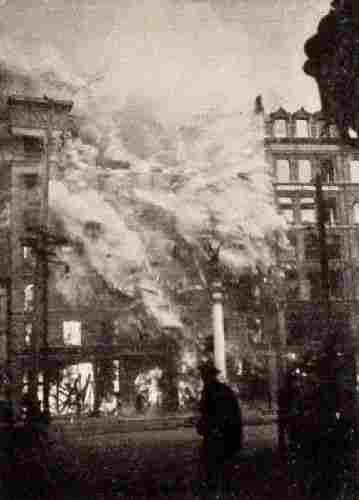
Destruction of the Emma Spreckels Building,
on the First Floor of Which Was “Zinkands.”
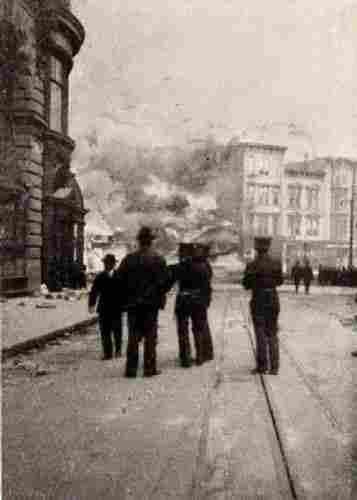
On Powell Street at Market, South Side of Latter in Flames.
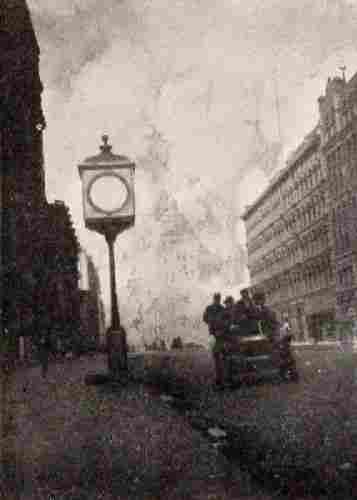
On Market, James Flood Building on Left,
Academy of Sciences at Right.
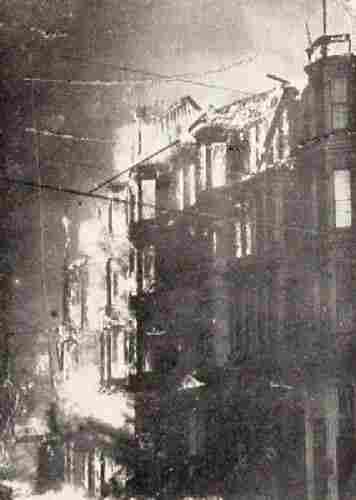
Burning of the Cosmopolitan Hotel, Night Scene.
Ruins of the Palace Hotel, from in Front of the Chronicle Office,
Unfinished Monadnock Building at Right, Market Street.
Another View of the Palace Hotel; Ruins of the Grand Hotel in Foreground;
Taken from the Corner of Montgomery Street.
Ruins of the Tower and Market Street Front of the City Hall;
Statue of Liberty and the Argonauts Stands Undisturbed.
View of the City Hall from the Larkin Street side,
with the site of the Mechanics’ Institute in the immediate foreground.
View of the St. Francis Hotel, corner of Geary and Powell Streets,
shows ruins of the John Bruner, and Cordes Furniture Co.’s Buildings at left;
part of Union Square and new addition to the Hotel on right.
Hall of Justice, Kearny Street and Portsmouth Square showing shattered tower and gutted doors.
Market Street, from Eighth, looking to the Call Building, showing the Grant Building,
in which were Headquarters Division of the Pacific, ruins of Odd Fellows’ Building on right.
Market Street east towards the Ferry, showing the Donohue Building and James
Flood Building on north side; Call Building, The Emporium and Hale Brothers’
Department Store on south side.
Hale Brothers’ Department Store, Sixth and Market Streets.
From Geary and Stockton Streets to Market, showing the City of Paris
Department Store and Mutual Bank Buildings on right; Marchand’s Cafe,
the Spaulding Building, the Graystone Hotel and the old Chronicle Building on left.
A view of the Retail and Hotel Districts, from Jones and Bush Streets to the Bay and Potrero Heights,
and from Market and Sansome to Market and Sixth Streets.
Pine Street, Financial District, looking west, Merchants’ Exchange on left.
Sacramento Street, from Kearny towards the Ferry,
Pacific Mutual Building, corner Montgomery.
Cable Power-House ruins, corner California and Hyde Streets.
Post Street and Powell to Market, showing on left ruins of the Savoy Hotel, Union League Club,
Pacific-Union Club, Shreve Building, Bohemian Club and Union Trust Bank Buildings.
Out Kearny Street from the corner of Union Square Avenue towards Telegraph Hill,
small portion of new Chronicle Building on right.
From the corner of Market and Post, looking north on Montgomery Street,
showing on right the Union Trust Co.’s Building,the Central Bank, the ruins of the
Occidental Hotel, the Mills Building and the Stock Exchange; Site of the Masonic
Temple and Bullock-Jones Building on left.
Looking north up Stockton Street from Geary, showing the Dana Building
and the ruins of the Pacific-Union Club, Union Square Park at left.
From Market, North on Mason Street to Knob Hill; Showing the Tivoli Theatre
Opposite the Poodle Dog, at the Corner of Eddy Street, Also Native Sons’ Hall
and the Fairmount Hotel in Distance.
Ruins of the Columbia Theatre, on Powell Street,
the Highest-class Play-house of the City.
The New Tivoli Opera House, Corner of Mason and Eddy; on the Site of the Old
Tivoli Music Hall; the Home for Years of the Tivoli Comic Opera Stock Company.
The Majestic Theatre, on Market Near Eighth Street.
The Central Theatre, on Market Street.
The Claus Spreckels One Million Dollar Brownstone Residence on Van Ness Avenue;
the Residence to the Left Was Dynamited to Stop the Flames.
The Flood Mansion on Knob Hill, at California and Powell Streets; the Brown Sandstone
in This Residence Was Brought Around the Horn in Sailing Vessels in the Early Fifties.
The Crocker Residence on Knob Hill, Corner of Jones and California Streets;
Running-gear of an Auto-Car Caught by the Flames.
The Ruins of the Mark Hopkins’ Institute of Art, Corner California and Mason Streets,
Which Contained the Finest Collection of Paintings by Renowned Masters, on the Coast;
the Pictures Were Cut Out of Their Frames by Blue-jackets and Saved.
The Orpheum Theater, on O’Farrell Street, High-class Vaudeville;
the San Francisco House of the Orpheum Circuit.
This View Shows the Top of Knob Hill, and the Ruins of the Many Elegant Residences There on Mason, Taylor and Jones Streets
One Way,and on California, Sacramento, Clay, Washington and Jackson Streets, Running the Other Way.
Fischer’s Theatre, the Alcazar Theatre, and Delmonico Restaurant on O’Farrell Street.
The Marie Antoinnette Apartment House, on Van Ness Avenue.
The St. Dunstan Hotel, Corner of Sutter Street and Van Ness Avenue.
The Princeton Hotel, on Jones Street, Between Post and Sutter Streets.
The St. Andre and El Monterey Apartment Houses on Pine Street, Near Hyde.
The San Francisco Y. M. C. A. Building and Gymnasium, Corner of Mason and Ellis Streets.
The St. Boniface German Catholic Cathedral and Nunnery, on Golden Gate Avenue,
Between Leavenworth and Jones Streets.
Grace Methodist-Episcopal Church, on California and Stockton Streets.
St. Francis Roman Catholic Cathedral, on Vallejo Street, Corner Montgomery Avenue.
Ruins of the Chinese Baptist Church on Clay Street, Between Stockton and Powell Streets.
Center of Chinatown; Looking Up Dupont Street from Clay, Towards California Street.
Ruins of the Chinese Joss House on Waverley Place, Chinatown.
Looking Up Grant Avenue from Geary Street; the Three Columns in Center
are the Ruins of the Bohemian Club, Corner Post Street.
View of Kearny Street from Jackson, Showing the New Western Hotel,
Commercial Hotel and Hall of Justice.
Looking East on Commercial Street, from Kearny to Montgomery,
Showing the Pacific-Mutual Bank and Sub-Treasury.
The Emporium Department Store, South Side of Market Street, One Week After
the Fire; Showing the Rent in Wall at Top Story Caused by the Earthquake.
Looking North on Front Street from Jackson, in the Heart of the Wholesale District.
Looking West on Jackson from Montgomery Street, Up Knob Hill.
Looking from Union Square at the Base of the Dewey Monument, Down Post Street
at Stockton, Showing the Ruins of the Union League and the Pacific-Union Clubs,
and the Shreve Office Building.
South of Market; Taken from the Corner of Seventh and Folsom Streets,
Showing the U. S. Postoffice Left Center and Knob Hill Right Distance.
The Million-Dollar Cathedral and Convent of St. Ignacius,
at the Corner of Golden Gate and Van Ness Avenues.
At the Corner of Dupont and Clay Streets, in Chinatown,
Showing the Crumpled Tower of the Hall of Justice in the Left Center.
View Over Chinatown to Telegraph Hill and the Water Front,
from the Corner of California and Powell Streets.
All That is Left of Telegraph Hill District, from Broadway and Kearny.
The Famous Pacific Street and Barbary Coast, the Bowery of San Francisco,
Well Known to the Seamen of All Nations.
Ruins of the Large and Beautiful Temple Emanuel, on Sutter Street,
Near Powell Street, Effects of the Earthquake and Flames.
Panorama View, Looking South from Knob Hill at the Corner of Jones and California Streets; Showing to the Bay and Potrero Heights;
the Immediate Foreground was the Site of Many Hundreds of Good Family Hotels for Which the City Was Noted.
On California Street Near Van Ness Avenue; the Running-gears of the California
Street Cable Cars, Which Were Burned Where They Stood.
On Market Street at Ninth, One Week After the Fire; Refugees En Route to the Ferry;
Men of the Board of Public Works Repairing the Water Mains.
The Bread Line on Van Ness Avenue at Calvary Church Drawing Their Daily Rations
from the Army and Red Cross Relief Stations; as the Wholesale Stores Were
Destroyed, the Stocks of the Retail Stores Were Seized by the Authorities for a
General and Equitable Distribution to All.
Refugee Food and Coffee Station in Union Square, Dewey Monument and Other
Building corner of Powell and Geary Street.
Temporary Refugee Camp near Fort Mason.
Establishing Refugee Camp on Lombard Street, near Fort Mason.
Archbishop Montgomery Holding the Only Religious Services in the City of San Francisco,
on the Presidio Reservation, on Sunday, April 22, 1906.
Refugees Quartered in Army Dog-tents, on the Common, Near Fort Mason.
Refugees Quartered in Army Wall Tents on the Presidio Reservation.
Refugee Camp on Gas-House Flats, at Lombard Street, Near Fort Mason.
Los Angeles’ Relief Committee’s Food Station in Golden Gate Park;
first hot meals in three days for rich and poor Refugees alike.
Refugee Camp in Golden Gate Park, one week old; U. S. Army tents.
Same Refugee Camp in Golden Gate Park, two weeks old;
board barracks taking the place of the tents.
The largest Refugee Camp, on the Presidio Reservation;
United States Army General Hospital showing.
Refugee bread line at the Relief Station at Calvary Church,
formed and controlled by U. S. Marines.
Another view of the big Refugee Camp on the Presidio Reservation;
circus tent being used as the Emergency Medical Supply Depot.
Refugees occupying vacant lots at the corner of Lombard and Van Ness Avenue;
Fort Mason in the center distance.
Two substantial Refugee Camps, one on the Fort Mason Reservation,
the other on Gas-House Flats, at Lombard Street.
View showing the Cantonment on the Presidio Reservation, Cavalry and Artillery Barracks,
and the Corral for the pack-trains used by the Army to transport the Relief Committee’s
supplies to the different camps.
United States Torpedo Boat Destroyer Paul Jones,
which rendered excellent service protecting shipping and wharfage.
Panorama View from Sutter and Jones Streets; the center of the Family Hotel and Boarding-House District;
showing the Wreck and Ruin of many fine Apartment Houses and Hotel Buildings.
Refugee Camp on Bush Street, near the St. Dominic Cathedral.
Refugee Camp No. 6, at Harbor View.
The United States Battleship Ohio, which furnished many marines for patrol duty,
and whose engines pumped much water for the Fire Department, saving wharfs and shipping.
“Searching for the Missing,” one of many sad scenes during those awful days;
the dead from the earthquake wrecks were hastily buried in the parks, squares
and vacant lots, some in known, but many more in unidentified graves; those who
perished in the flames were lost, never to be found, and their number will never be known.
SAN FRANCISCO’S HONOR ROLL
BRILLIANT AND SELF-SACRIFICING WORK OF THE COMMITTEE OF ONE HUNDRED WHO STOOD BY THEIR BELOVED CITY IN THE HOUR OF HER DARKEST PERIL
MAYOR SCHMITZ AND HIS CO-WORKERS, GENERAL FUNSTON AND THE BOYS IN BLUE, THE SALVATION OF A STRICKEN CITY
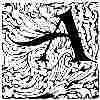 fter the Earth jumped back on its track at 5:13:47 on the morning of Wednesday, April 18th, 1906, the citizens of San Francisco came down on their feet in fighting mood, and the success of that fight has aroused the wonder and admiration of the entire world. Being true sons of their fathers they showed the thoroughbred strain in time of stress and peril just as did those fathers before them. There was no denying the fact that many thought it the end of time, listened for the trumpet of Gabriel to echo through the crash of worlds, and looked toward the heavens to see the angel with the flaming sword, but they stood to meet it like men, backed as they were against the wall. When walls ceased falling and they had rubbed the dust from their eyes, they found that they still lived; it was then that they shut their jaws and began to fight. They have been fighting ever since and will continue to fight until San Francisco shall have been restored even beyond the dreams of those fathers.
fter the Earth jumped back on its track at 5:13:47 on the morning of Wednesday, April 18th, 1906, the citizens of San Francisco came down on their feet in fighting mood, and the success of that fight has aroused the wonder and admiration of the entire world. Being true sons of their fathers they showed the thoroughbred strain in time of stress and peril just as did those fathers before them. There was no denying the fact that many thought it the end of time, listened for the trumpet of Gabriel to echo through the crash of worlds, and looked toward the heavens to see the angel with the flaming sword, but they stood to meet it like men, backed as they were against the wall. When walls ceased falling and they had rubbed the dust from their eyes, they found that they still lived; it was then that they shut their jaws and began to fight. They have been fighting ever since and will continue to fight until San Francisco shall have been restored even beyond the dreams of those fathers.
The first effective work began with Mayor Eugene E. Schmitz and the members of the Police Commission, who had quickly assembled at the Hall of Justice. It was a time when no man could stop to think twice; immediate action must be taken; action that must be absolutely correct on the first thought. The first official action was to send out police to close each and every saloon.
Everywhere the streets were filled with the debris of fallen walls and cobwebbed with a tangle of dangling wires, among which half a million of people stood numb and dazed or groped their way blindly, not knowing where to go nor what to do. In a dozen widely scattered localities smoke devils were dancing from roof to roof and people gave way mechanically for the clanging apparatus rushing wildly to the fires.
In collapsed buildings there were many dead, but “let the dead care for the dead;” there were those yet living pinned under fallen walls and beams. There were hundreds and hundreds of injured to be succored. There were hundreds of millions of dollars in shattered banks, the savings of the people, to be guarded against the time when some men go mad and seize on the possessions of a neighbor as one crazed brute snaps at another. That was the situation, in brief, that confronted the Mayor, the Police Commission and the six hundred policemen of San Francisco, a handful to cope with disaster by earthquake, fire, and the elements of chaos that a city of half a million breeds.
The Mayor and the Police Commission had barely entered into conference when this message came to them from Brigadier General Frederick Funston: “Do you need help?” Did they? “Yes, send all the troops you can,” was the reply dispatched with all the haste of a city’s need. Then the conference went on. It was brief. The situation demanded the co-operation of the entire city.
A Citizens Committee of Safety was hurriedly decided upon, and the Mayor compiled the following “Committee of One Hundred” of the prominent citizens of the city in all walks of life: Mayor Eugene E Schmitz, chairman; Rufus P. Jennings, secretary; Frank B. Anderson, Hugo K. Asher, W. J. Bartnett, Maurice Block, Hugh M. Burke, Albert E. Castle, Arthur H. Castle, Paul Cowles, H. T. Creswell, Henry J. Crocker, R. A. Crothers, P. C. Currier, Jeremiah Deneen, E. J. De Pue, M. H. De Young, George L. Dillman, A. B. C. Dohrmann, J. J. Dwyer, Charles S. Fee, John W.[Pg 110] Ferris, Tirey L. Ford, Thomas Garrett, Mark L. Gerstle, Wellington Gregg, Jr., R. B. Hale, William Greer Harrison, J. Downey Harvey, I. W. Hellman, Jr., Francis J. Heney, William F. Herrin, Dr. Marcus Herzstein, Howard Holmes, J. R. Howell, Judge John Hunt, D. V. Kelly, Homer S. King, George A. Knight, Franklin K. Lane, Herbert E. Law, W. H. Leahy, J. J. Lerman, C. H. Maddox, Frank Maestretti, Thomas Magee, W. A. Magee, John S. Mahoney, John Martin, Garret McEnerney, John McLaren, John McNaught, S. B. McNear, William M. Metson, Archbishop Montgomery, E. F. Moran, Irving F. Moulton, Thornwall Mullally, S. G. Murphy, Bishop Nichols, Father O’Ryan, James D. Phelan, Albert Pissis, Willis Polk, Allan Pollok, E. B. Pond, H. B. Ramsdell, James Reid, J. B. Reinstein, David Rich, Dent H. Robert, J. B. Rogers, John W. Rogers, Andrea Sbarboro, Henry T. Scott, W. P. Scott, Frank Shea, S. M. Shortridge, Claus Spreckels, Rudolph Spreckels, I. Steinhart, Gustav Sutro, W. W. Thurston, Clem Tobin, George Tourny, Fred Ward, Charles S. Wheeler, Thomas P. Woodward, and John P. Young.
These names with addresses from the City Directory, were at once placed in the hands of a detail of policemen, a few names to each member of the squad, with instructions to have the Committee at the Hall of Justice by 3 o’clock in the afternoon.
This work had barely been commenced when the rhythmic tramp, tramp, tramp, of many feet was heard on the street, as column alter column of the blue-shirted lads swung by, each carrying a short Krag rifle with a belt of ball cartridges. Their officers reported to the Chief of Police, who assigned each a district to patrol and detailed a policeman to guide each command to its post. No one not on Market Street or in the downtown district at that time can appreciate the feeling of relief that came over all as those silent, quiet, business-like boys swung by with the steadiness and precision of a machine, passing under tottering walls and entering the danger zone with dynamite and gun-cotton to raze buildings from the path of the fire.
The deeds of heroism and the courage displayed by regulars, militiamen, police, firemen, and civilian volunteers on the 18th and 19th will never be told; they can not be. They were occurring constantly, a dozen in a block, throughout the city, and there was no time for names or details. Firemen, regulars, police, and civilian volunteers worked in the heat and smoke and noxious gases until they were overcome and fell in their tracks. They were dragged back and others stepped into the breach, to be dragged back in turn when they fell. Firemen fought with the determination of despair and cried like children when the failure of water deprived them of their weapon.
Before the hour set for the meeting of the Citizens’ Committee the entire city was threatened with destruction. The sky was obscured with a pal of smoke through which swung the sun like a blood-red ball; great sheets of flame writhed and swirled through the smoke, and underneath all 300,000 men, women and children fled for their lives, tottering under their most valuable possessions, while 100,000 more were preparing for flight. That was the situation when the above named citizens met at the Hall of Justice at the call of the Mayor at three o’clock on the afternoon of the 18th.
They assembled first in the office of the Chief of Police, but another shock threatened to bring the tower down on their heads and drove them to the office of the central station, in the basement, and it was not long before they were driven from there to Portsmouth Square. There in the open air surrounded by thousands of frightened Chinese and residents of the district, was the seat of municipal government during the late afternoon and early evening. Then a dynamited building cast its debris of bricks, mortar and broken glass over the square, and government and advisory committee hastily adjourned to the Fairmount Hotel on Knob Hill. Headquarters had been established there but a short time when it was driven back by the advancing wall of fire and an adjournment was taken until Thursday morning at 9 o’clock, to meet at the north end police station, 1712 Washington street.
When the Mayor, Police Commission and Citizens’ Committee of One Hundred met Thursday morning, the following sub-committees were appointed and immediately commenced work:
Resumption of Civil Government, not including Judiciary—Garret McEnerney, chairman.
Resumption of the Judiciary—Charles W. Slack, chairman.
Resumption of Transportation—Thornwall Mullally, chairman.
Automobile Committee—R. B. Hale, chairman; Gavin McNab, I. W. Raphael, George Smith, Robert Park, Michael Casey, J. R. Howell and Mr. Harris.
Transportation of Refugees—Thomas Magee, chairman; George A. Hensley.
Restoration of Water—Frank B. Anderson, chairman; George L. Dillman, secretary; A. S. Porter, A. H. Payson, H. Schussler, and Mr. Lane.
[Pg 111]Restoration of Light and Telephone—Rudolph Spreckels, chairman; A. M. Hunt, secretary; Charles S. Wheeler, T. C. Friedlander, J. Martin, C. O. Lyman, Louis Glass, and F. M. Lamb.
Relief of Hungry—Rabbi Voorsanger, chairman; Oscar Cooper, secretary; John S. Drum, S. B. McNear, Hugo K. Asher, W. P. Scott, Maurice Block, W. W. Thurston, and A. B. C. Dohrmann.
Housing the Homeless—W. J. Bartnett, chairman; M. J. Cerf, secretary; R. M. Countryman, John H. Speck, J. Dalzell Brown, and Charles S. Fee.
Restoration of Fires in Dwellings—Jeremiah Deneen, chairman; J. J. Mahony and George F. Duffey.
Finance Committee of the Relief and Red Cross Funds—James D. Phelan, chairman; J. Downey Harvey, secretary; William Babcock, Horace Davis, M. H. De Young, Frank G. Drumm, James L. Flood, I. W. Hellman, Jr., William F. Herrin, Rufus P. Jennings, Herbert E. Law, Thomas Magee, Garret McEnerney, John P. Merrill, W. W. Morrow, Allan Pollok, Rudolph Spreckels, Charles Sutro, Jr., and Joseph S. Tobin.
Roofing the Homeless (Sub-committee of Housing the Homeless)—Fairfax H. Wheelan, chairman; Miss Katherine Felton, O. K. Cushing, and F. J. Symmes.
Press Agent—I. Choynski, chairman.
Drugs and Medical Supplies—Dr. Harris, chairman; Father O’Ryan, Judge Hunt, J. J. Lermen, W. H. Metson, Dr. McGill, Dr. Garceau, and Max Mamlock.
Relief of Sick and Wounded—Miss Katherine Felton, chairman; Mrs. John F. Merrill, Fairfax H. Wheelan, O. K. Cushing, and Dr. James W. Ward, sanitation.
Relief of Chinese—Rev. Dr. Filben, chairman.
Permanent Location of Chinatown—Abraham Ruef, chairman; James D. Phelan, Jeremiah Deneen, Dr. James W. Ward, and Dr. Filben.
Restoration and Resumption of Retail Trade—Geo. W. Wittman, chairman; H. D. Loveland.
Citizens’ Police Committee—H. U. Brandenstein, chairman.
Auxiliary Fire Committee—A. W. Wilson, chairman.
Restoration of Abbattoirs—Henry Miller, chairman.
History and Statistics—John S. Drum, chairman; E. F. Moran, secretary; Richard C. Harrison, and Clement Bennett.
Organization of the Wholesalers—William Babcock, chairman.
Martial law having been declared, one of the first orders of the Citizens’ Committee was embodied in the first proclamation of the Mayor: “Troops and police are authorized to kill on sight any person or persons caught looting.” After that there were occasional reports in the burned districts; they may have been exploding automobile tires—no one stopped to inquire. Anyway, there was no further looting.
The sub-committees had barely time to organize when the fire swept over the hills and they were again driven out. The Mayor issued an order that all records saved and the municipal government be removed to the Police Station at Haight and Stanyan Streets, far out by Golden Gate Park, for a last stand. At the same time he ordered an adjournment of all committees to Franklin Hall, at the corner of Bush and Fillmore Streets, thus establishing headquarters as near the fire line as practicable. If burned out there his orders were for all to rally at the Park Police Station.
That was at noon on Thursday; within thirty hours the Committee had been organized by men who left their property to destruction and within the same length of time the committee had been burned out four times and located the fifth headquarters. The city had been policed by regulars, militiamen and volunteers, and the most disastrous fire in history was under control.
The care of the injured, the feeding of the hungry and the housing of the homeless were the first consideration of the Committees, and for the first day or two all else was subordinated to these works of mercy.
It will require a large book to tell the details of the work of these committees, each being aided by hundreds of volunteers. Each member of a committee being vested with police powers, and automobiles, carriages and wagons of all kinds were impressed wherever found; their loads were dumped on the sidewalks and filled with the injured or medical and food supplies, the vehicles hurried on to destinations named by the committeemen.
The rapidity with which the Committee effected an organization and relieved the suffering and hunger of nearly 300,000 people is noteworthy. Changing headquarters five times and organizing and planning as the members fled along the streets was no easy task, but it was accomplished and for nearly a week these committees arranged and cared for the homeless multitude.
The rapidity with which organization was effected and order enforced, is what amazes the knowing world today. It was done by citizens of San Francisco, backing up their executive with their lives and their fortunes, and back of them stood their friends in the breadth and length of these whole United States. As did the fathers of fifty years ago, so did the sons of today.
(San Francisco Chronicle, May 9th 1906.)
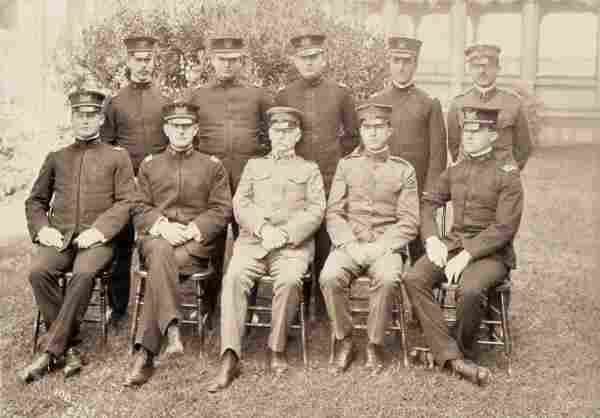
| 1. | Lieut. Col. George H. Torney, deputy surgeon general, commanding. |
| 2. | Capt. James M. Kennedy, assistant surgeon. |
| 3. | Capt. Henry H. Rutherford, assistant surgeon. |
| 4. | Lieut. John H. Allen, assistant surgeon. |
| 5. | Lieut. Roderic P. O’Connor, assistant surgeon. |
| 6. | Lieut. Herbert M. Smith, assistant surgeon. |
| 7. | Capt. Wilson T. Davidson, assistant surgeon. |
| 8. | Lieut. Robert E. Noble, assistant surgeon. |
| 9. | Lieut. James F. Hall, assistant surgeon. |
| 10. | Lieut. John L. Shepard, assistant surgeon. |
DEPUTY SURGEON GENERAL, COMMANDING, AND THE MEDICAL STAFF OF THE
UNITED STATES ARMY GENERAL HOSPITAL, PRESIDIO, SAN FRANCISCO, CALIFORNIA.


